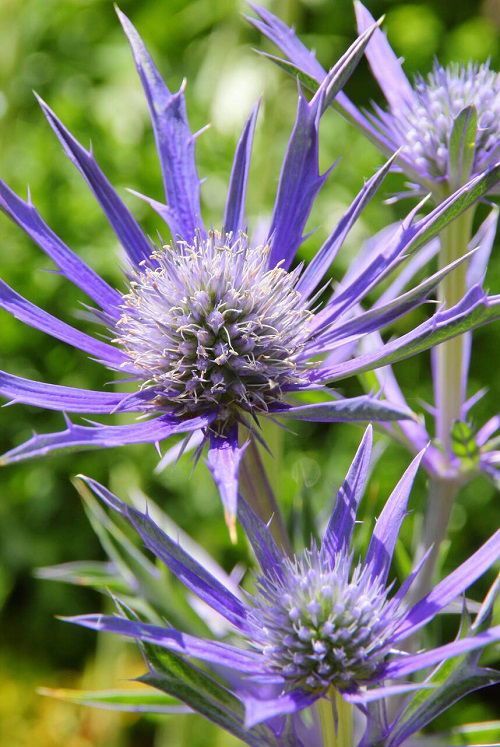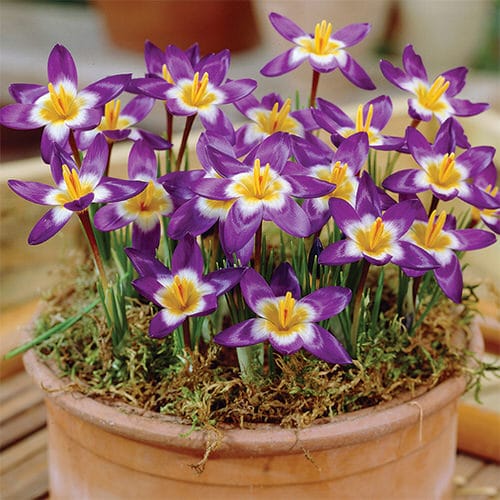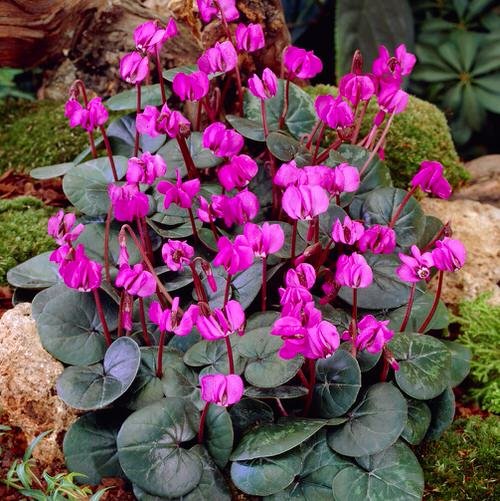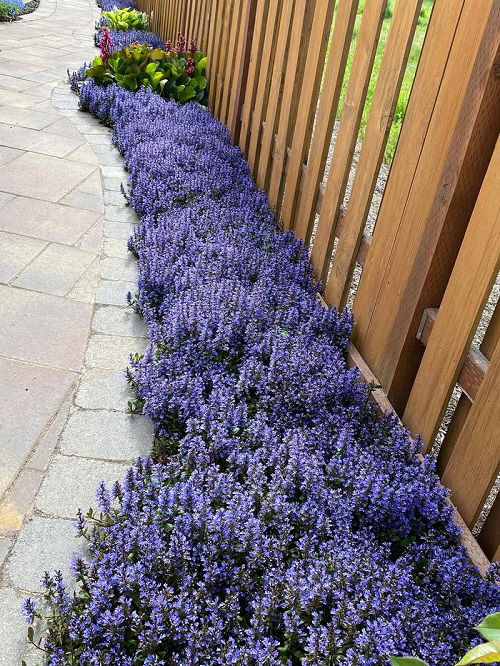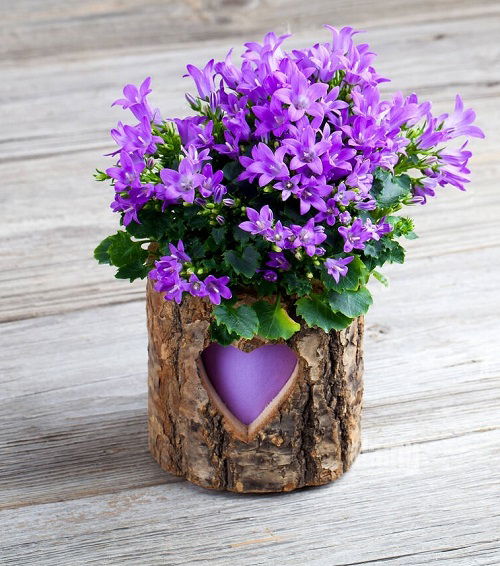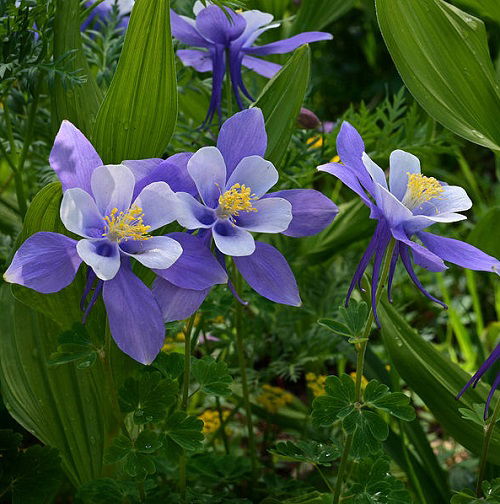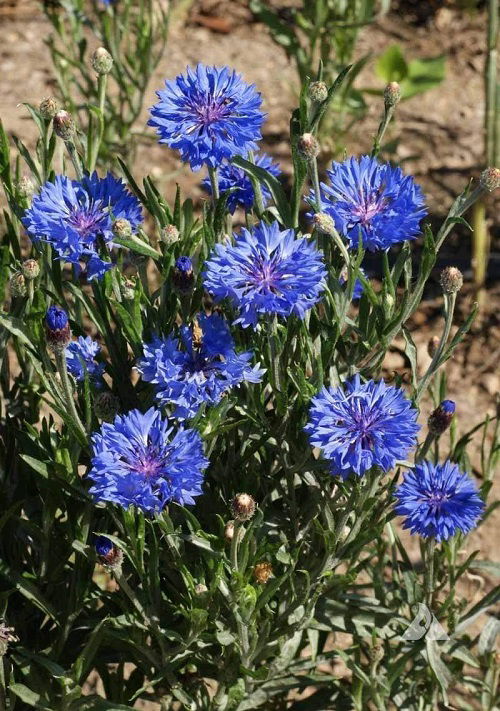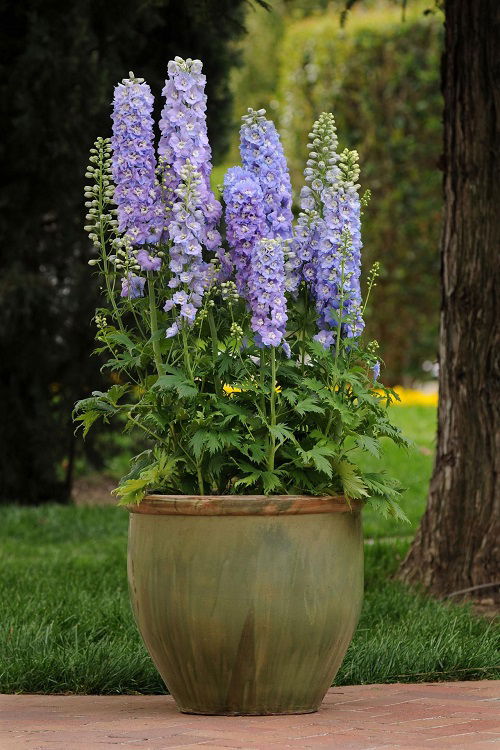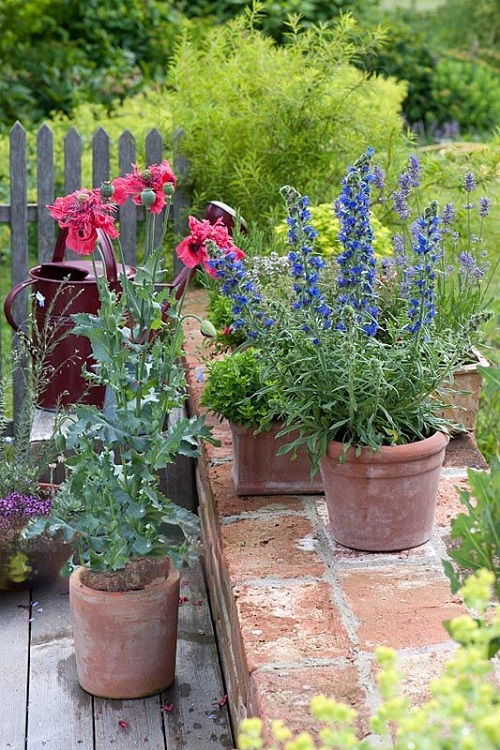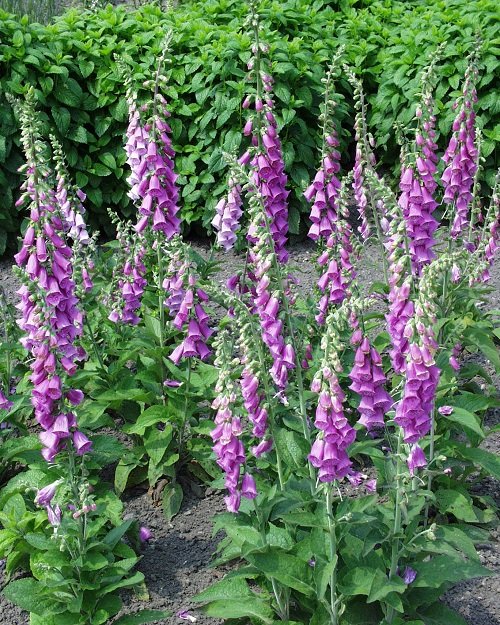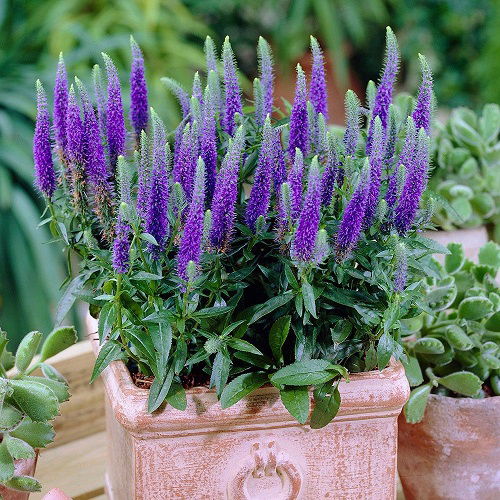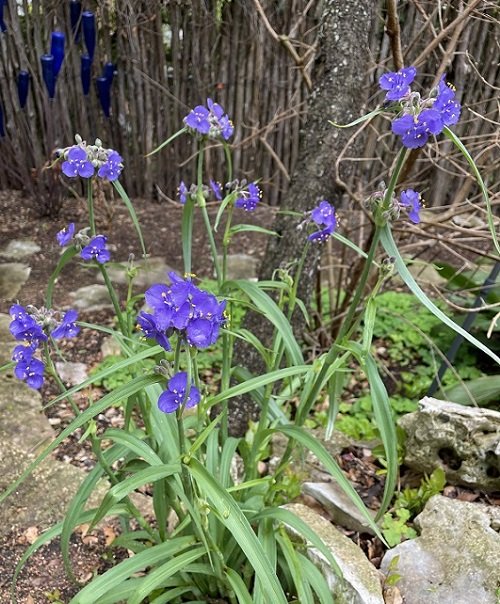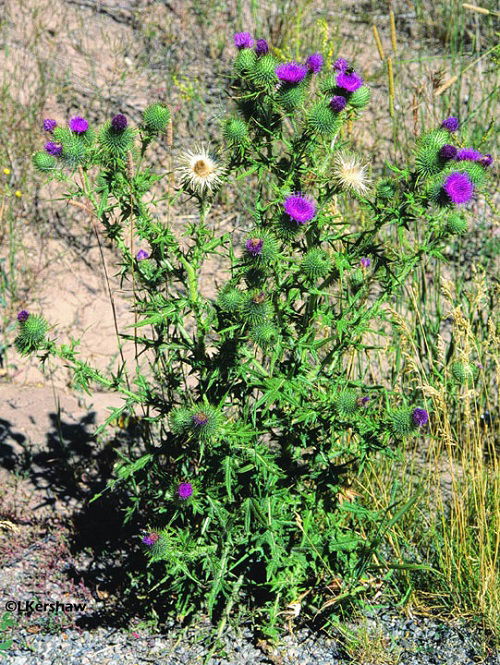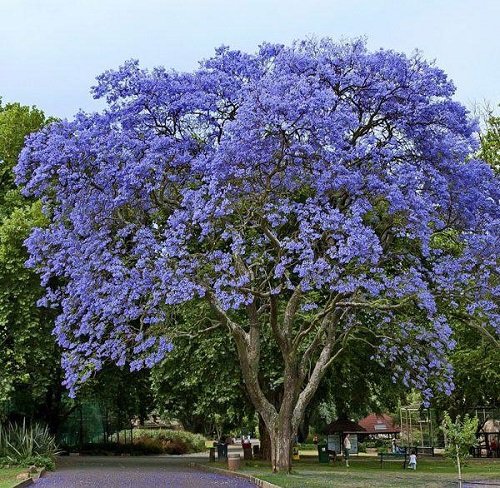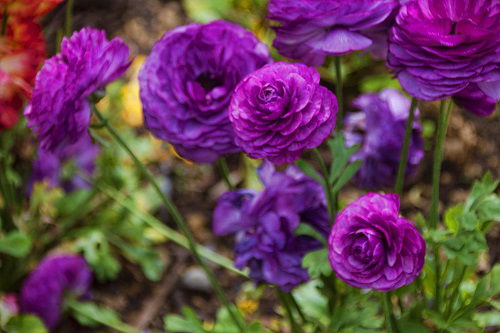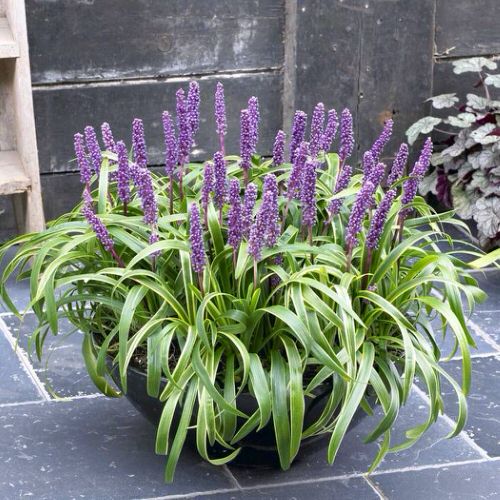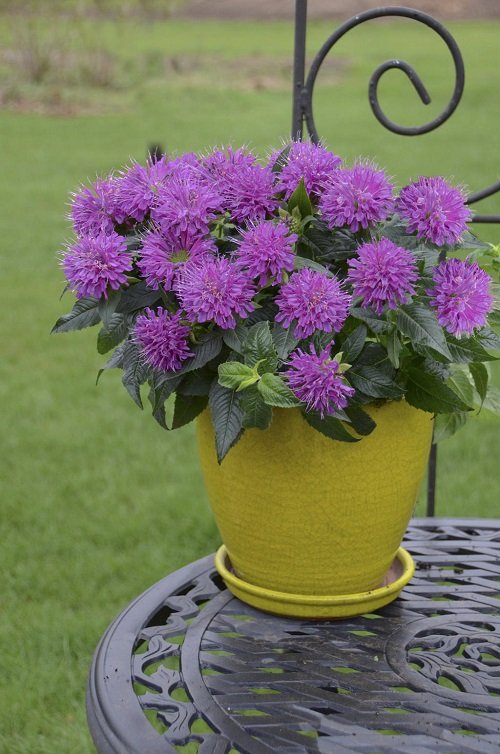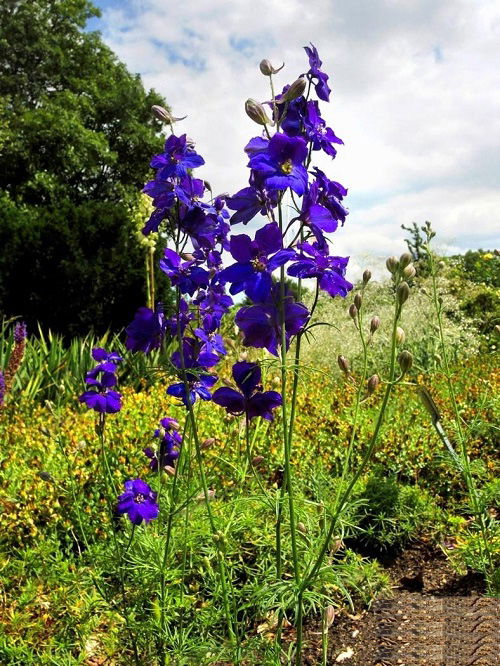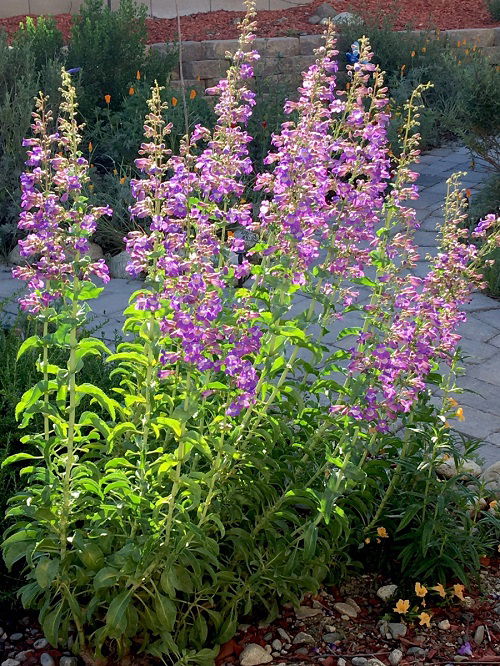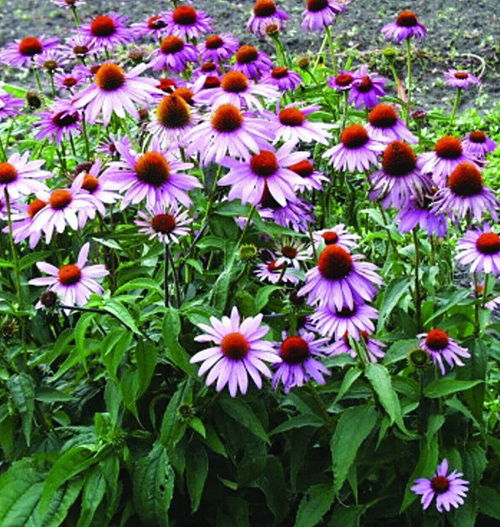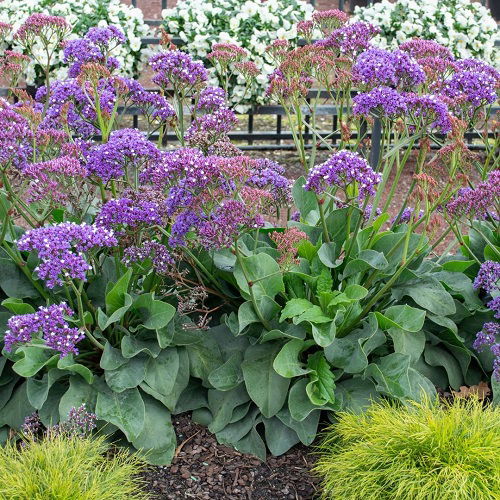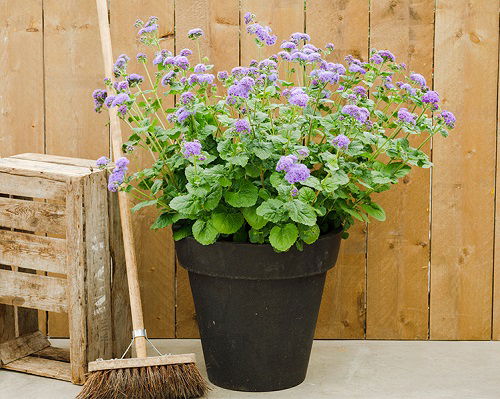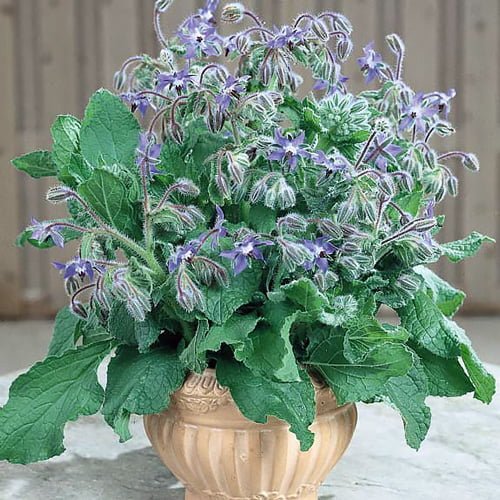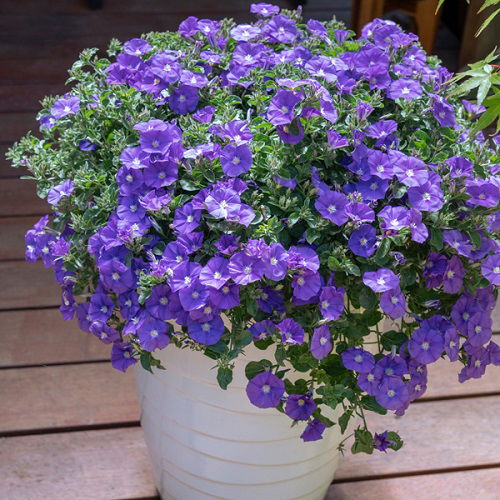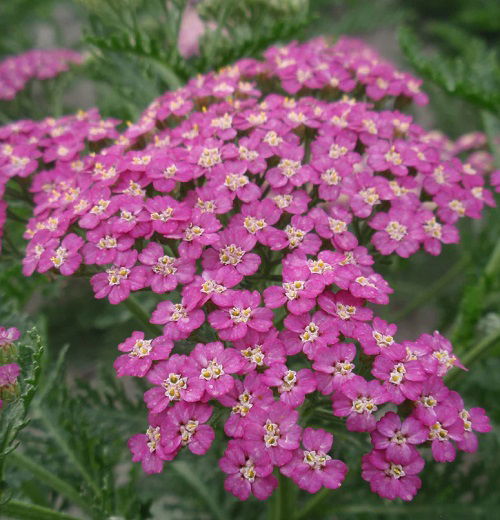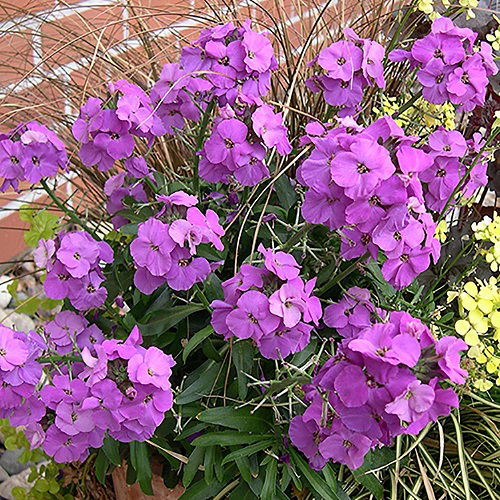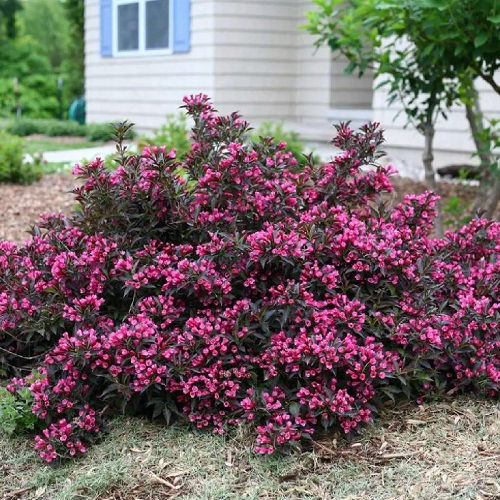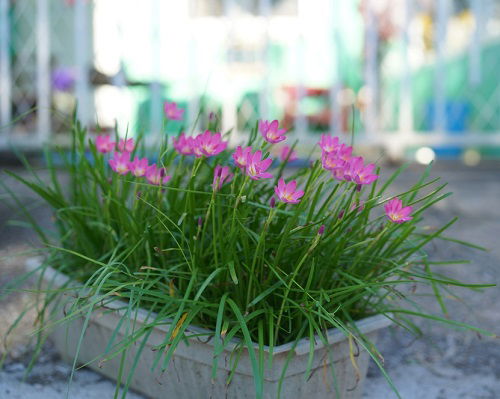Purple Flowers not only look royal but also add a touch of spirituality and creativity to the garden. Explore this list of the best ones!
Purple Flowers are a must-have in the garden and stand out when grown with other colorful flowers. We have included the best names for you with pictures.
Most Stunning Types of Purple Flowers
Some of the flowers here might not have an exact purple shade and may have a mix of blue, violet, or lilac in their hue.
1. Verbena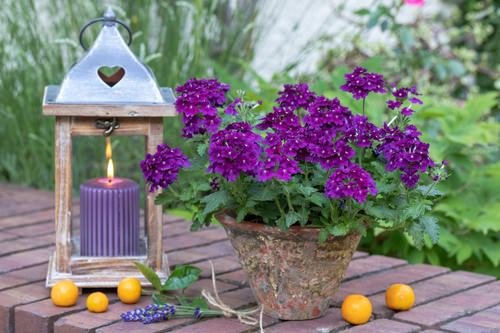
Botanical Name: Verbena
USDA Zones: 7-11
Container Gardening: Possible
Starting the Types of purple flowers list is Verbena. The tall flower stalks of verbena bear a cluster of stunning purple blooms. You can use them in place of ornamental grasses as well.
Growing Tip: Verbena flowers require full sun, well-draining soil, and regular watering to maintain consistent soil moisture levels. Feeding them with a balanced fertilizer every 4-6 weeks during the growing season promotes healthy growth and vibrant blooms.
2. Butterfly Bush

Botanical Name: Buddleja
USDA Zones: 5-10
Container Gardening: Possible
Long and narrow tufts of tubular flowers that are rich in nectar and attract butterflies, this Purple flowering bush is an absolute beauty.
Growing Tip: Butterfly Bush thrives when exposed to full sun, needing at least 6-8 hours of direct sunlight daily. It prefers well-draining soil to prevent root rot and benefits from moderate and consistent watering. Occasional feeding with a balanced fertilizer during the growing season promotes healthy growth.
3. Gloxinia

Botanical Name: Sinningia speciosa
USDA Zones: 10-11
Container Gardening: Possible
Large trumpet-shaped flowers have a velvety touch to them and can grow annually. They are also a great choice to grow in pots, even indoors.
Growing Tip: Gloxinia flourishes in bright, indirect light, or filtered sunlight, making it an excellent choice for indoor settings. The soil should be well-aerated and moisture-retentive, often achieved by mixing potting soil with perlite. Avoid overwatering, and maintain consistent soil moisture.
4. Sweet Pea
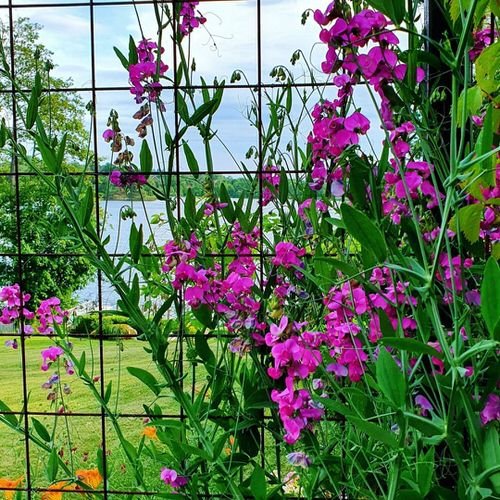
Botanical Name: Lathyrus odoratus
USDA Zones: 2-11
Container Gardening: Possible
The fragrant Purple flowers of sweet peas make for a serene addition to gardens and our Types of purple flowers list. The plant is also very easy to grow and maintain.
Growing Tip: Sweet Peas require full sun to partial shade exposure and well-draining soil. Keeping the soil consistently moist without letting it become waterlogged. Feeding with a balanced fertilizer every few weeks during the growing season helps ensure a bountiful display of fragrant blooms.
Here are the Best Groundcovers With Purple Flowers
5. Purple Hibiscus

Botanical Name: Hibiscus
USDA Zones: 5-9
Container Gardening: Possible
Whether you grow Rose of Sharon or tropical hibiscus, both have purple flowering varieties. The large blooms look great in gardens.
Growing Tip: Purple Hibiscus thrives in locations with full sun to partial shade. It prefers well-draining soil and benefits from consistent moisture in the soil. To encourage lush flowering, apply a balanced fertilizer during the growing season.
6. Calla Lily
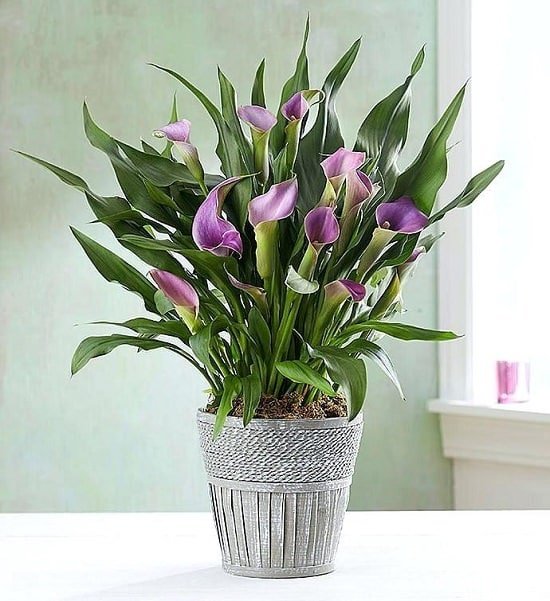 Botanical Name: Zantedeschia
Botanical Name: Zantedeschia
USDA Zones: 8-10
Container Gardening: Possible
Not a true lily, the plant is also famous as the Arum lily. These Types of purple flowers are native to Southern Africa and also come in other shades.
Growing Tip: Calla Lilies thrive in bright, indirect light and well-draining soil. Keep the soil consistently moist but avoid waterlogging, and fertilize sparingly to prevent over-fertilization.
Stunning Purple Calla Lily Varieties
7. Zinnia
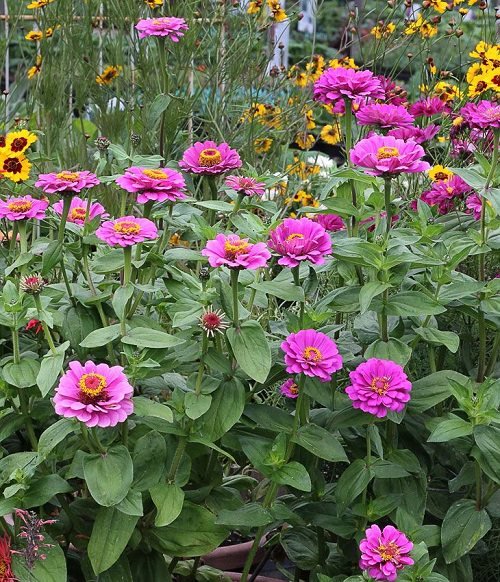
Botanical Name: Zinnia
USDA Zones: 3-10
Container Gardening: Possible
Easy to grow Types of purple flowers for beginners; its cheerful, bright flowers appear in many colors.
Growing Tip: Zinnias flourish in full sun, making them ideal for sunny gardens. They prefer well-draining soil and need moderate, consistent watering. Occasional feeding with a balanced fertilizer enhances their growth and vibrant flower production.
8. Hydrangea
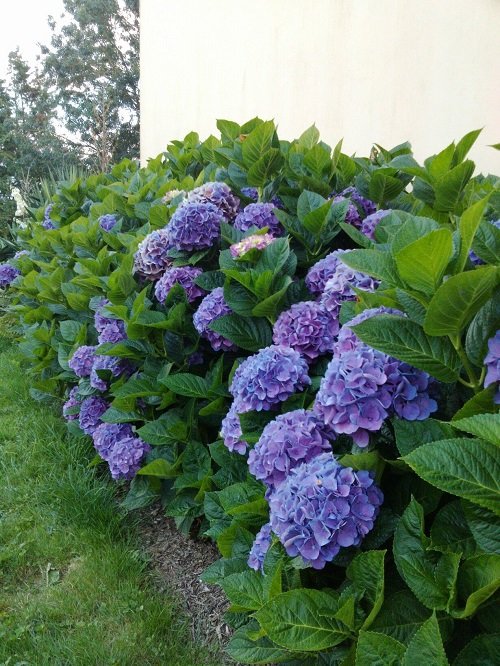
Botanical Name: Hydrangea macrophylla
USDA Zones: 5-9
Container Gardening: Possible
The flower color of hydrangeas depends on soil pH, and you can adjust it to have Purple flowers and other shades.
Growing Tip: Hydrangeas prefer partial sun to shade and well-drained, humus-rich soil. Keep the soil consistently moist, especially during hot weather, and apply fertilizer in spring and early summer to promote healthy blooms.
9. Chinese Wisteria
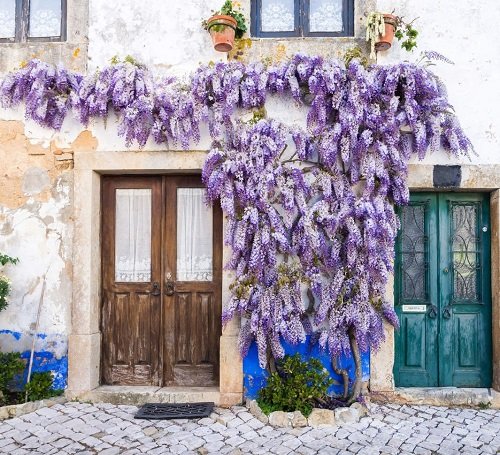
Botanical Name: Wisteria sinensis
USDA Zones: 5-8
Container Gardening: Not Possible
When it blooms, it’s a sight to withhold with clusters of drooping Purple flowers. Do make sure to trim it at regular intervals as the plant is invasive.
Growing Tip: Chinese Wisteria requires full sun, well-drained soil, and regular watering to establish deep roots. Light feeding with a balanced fertilizer in spring supports their growth and flowering.
Here are the Best Trees with Purple Flowers in Texas
10. Sea Holly
Botanical Name: Eryngium
USDA Zones: 5-9
Container Gardening: Possible
A head-like cluster of small spiny bracts accompanies these small Types of purple flowers, which present an intriguing form.
Growing Tip: Sea Holly thrives in full sun, adapting well to well-drained sandy or loamy soil. They are drought-tolerant once established, requiring moderate watering. Minimal fertilization is necessary for their growth.
11. Pincushion Flower
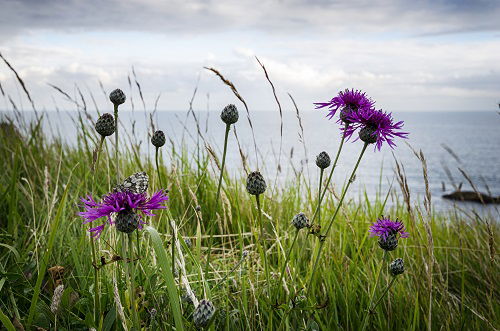
Botanical Name: Scabiosa
USDA Zones: 3-9
Container Gardening: Possible
The thin, wiry stem holds the blooms that sway gently in the wind. These small flowers are easy to grow and maintain as well.
Growing Tip: Pincushion Flowers prefer full sun, well-draining soil, and moderate watering. Apply a balanced fertilizer occasionally during the growing season to encourage continuous flowering.
12. Petunia
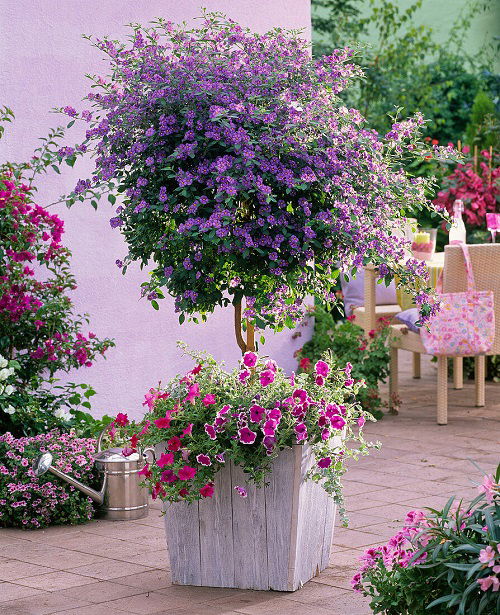
Botanical Name: Petunia
USDA Zones: 10-11
Container Gardening: Possible
One of the most popular Types of purple flowers, petunias look wonderful in hanging baskets too.
Growing Tip: Petunias love full sun exposure and well-draining soil. Keep the soil consistently moist, but avoid waterlogged conditions. Feeding every few weeks with a balanced fertilizer supports their growth and flower production.
13. Pasque Flower
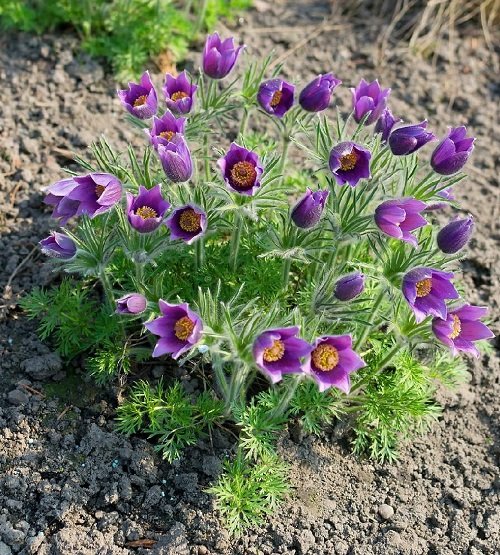
Botanical Name: Pulsatilla
USDA Zones: 3-8
Container Gardening: Possible
The fuzzy look of this plant can be attributed to the fine hairs that cover stems, leaves, and even flower buds.
Growing Tip: Pasque Flowers thrive in full sun to partial shade and well-draining soil. Keep the soil consistently moist but not soggy, and avoid over-fertilization.
Here are Beautiful Types of Purple Peony Varieties
14. Fuchsia

Botanical Name: Fuchsia
USDA Zones: 6-10
Container Gardening: Possible
Fuchsia flowers come in colors like pink, purple, red, white, etc. They’re perfect for hanging baskets.
Growing Tip: Fuchsias prefer partial shade, well-draining soil, and consistent moisture in the soil. Fertilize them sparingly during the growing season to encourage lush foliage and abundant blooms.
Best Fuchsia Varieties for Hanging Baskets and Pots
15. Morning Glory
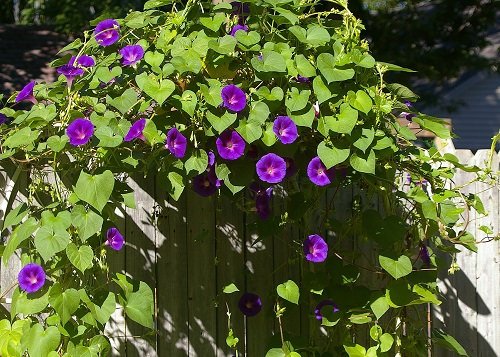
Botanical Name: Ipomoea
USDA Zones: 2-11
Container Gardening: Possible
An excellent tropical climber bears funnel-shaped blue, white, pink, or Purple flowers and can also be trained over a fence, pergola, or arbor.
Growing Tip: Morning Glory loves full sun exposure and well-drained soil. Keep the soil consistently moist, and light feeding during the growing season promotes vigorous vine growth and profuse flowering.
16. Aster
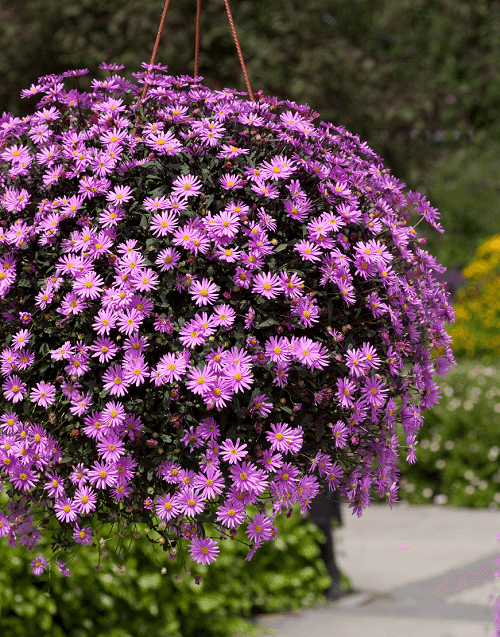
Botanical Name: Aster
USDA Zones: 3-8
Container Gardening: Possible
Looking for Types of purple flowers for the garden? These daisy-like perennials bloom from late summer to autumn, making the garden cheerful.
Growing Tip: Asters thrive in full sun, well-draining soil, and moderate watering. Applying a balanced fertilizer during the growing season enhances their growth and abundant fall blooms.
17. Prairie Gentian
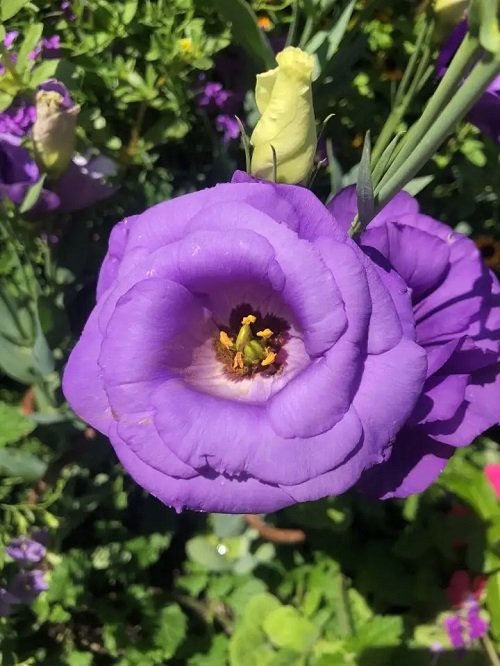
Botanical Name: Eustoma
USDA Zones: 8-10
Container Gardening: Possible
The five-petaled Types of purple flowers resemble roses in shape and also go by the name Lisianthus. The vivid shade of the Purple flowers is spectacular to look at.
Growing Tip: Prairie Gentians do well in full sun, requiring well-draining soil. Keep the soil consistently moist but avoid waterlogging, and feed occasionally during the growing season for optimal flowering.
Here are the Best Outdoor Purple Plants
18. Lilac

Botanical Name: Syringa
USDA Zones: 3-9
Container Gardening: Possible
Blooming in late spring, lilacs are deciduous shrubs that are highly fragrant. The Purple flowers of the plant come in clusters.
Growing Tip: Lilacs prefer full sun to partial shade and well-drained soil. Consistent moisture is essential, especially during dry spells, and feeding in spring helps promote robust flowering.
19. Annual Honesty

Botanical Name: Lunaria Annua
USDA Zones: 4-8
Container Gardening: Possible
Its notable part is the seed heads, which gleam with a silvery glow and are oval and translucent. These fragrant Types of purple flowers bloom in spring and early summer.
Growing Tip: Annual Honesty thrives in full sun to partial shade and well-draining soil. Keep the soil consistently moist, and light feeding with a balanced fertilizer supports healthy growth and seed pod development.
Check out the most gorgeous purple houseplants here
20. Hardy Geranium
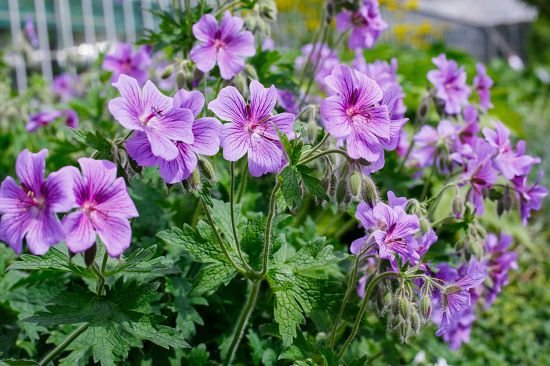
Botanical Name: Geranium bohemicum
USDA Zones: 5-8
Container Gardening: Possible
The dark Purple flowers in the truest shade of “purple” are a treat to watch. If you like purple, then this is the flower for you!
Growing Tip: Hardy Geraniums prefer partial to full sun and well-drained soil. Maintain even moisture levels in the soil, and occasional feeding during the growing season encourages continuous blooming.
21. Geraldton Waxflower
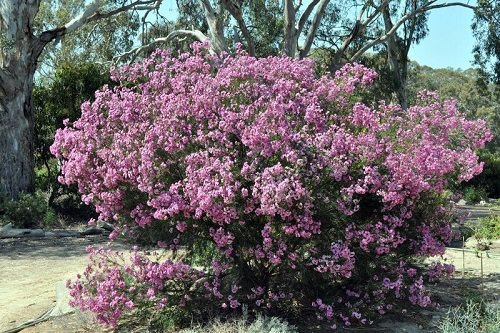
Botanical Name: Chamelaucium uncinatum
USDA Zones: 9-11
Container Gardening: Not Possible
The long stalk on which this waxy Australian flower grows makes it a great addition to flasks as a cut flower.
Growing Tip: Geraldton Waxflowers need full sun exposure and well-drained soil. They are drought-tolerant once established, requiring minimal watering and minimal fertilization.
22. Gladiolus
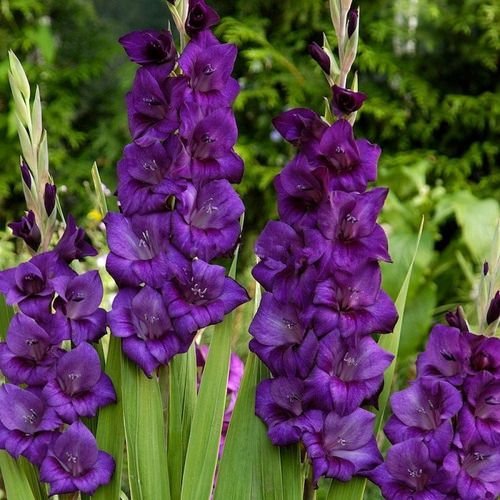
Botanical Name: Gladiolus
USDA Zones: 7-10
Container Gardening: Possible
Florists love to add these Types of purple flowers to bouquets and various floral arrangements. Plus, the spiky plant stands out in the garden due to its tall stature.
Growing Tip: Gladiolus thrives in full sun with well-drained soil. Keep the soil consistently moist but avoid waterlogging. Fertilize regularly during the growing season for tall, vibrant flower spikes.
Looking for Trees with purple flowers? Here are Beautiful Trees with Purple Flowers
23. Dendrobium Orchid
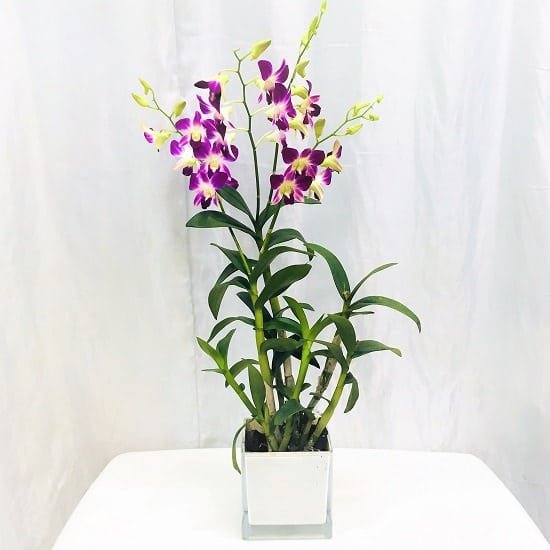
Botanical Name: Dendrobium
USDA Zones: 10-11
Container Gardening: Possible
If you are new to the world of orchids, the first one to go for is purple dendrobium. Its Purple flowers are simply awesome to look at!
Growing Tip: Dendrobium Orchids require bright, indirect light and well-draining orchid mix. Water moderately, allowing the roots to dry slightly between watering sessions. Fertilize with an orchid-specific fertilizer regularly.
24. Columbine
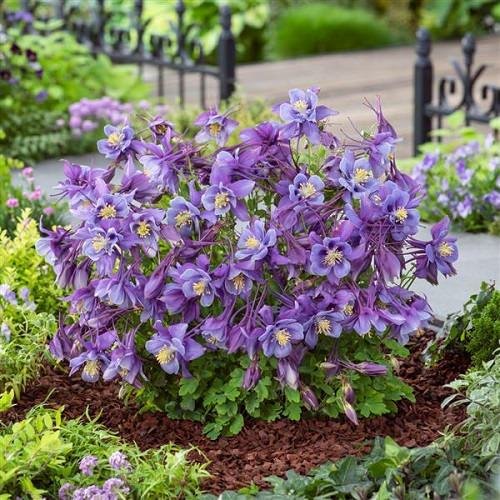 panamseed
panamseed
Botanical Name: Aquilegia
USDA Zones: 3-9
Container Gardening: Possible
Birds are attracted to the exquisite Columbine Purple flowers, which keep the bird lovers in a merry mood.
Growing Tip: Columbines prefer partial shade to full sun, well-drained soil, and moderate watering. They thrive when provided with consistent moisture. Occasional feeding with a balanced fertilizer promotes healthy growth and flowering.
25. Crocus
Botanical Name: Crocus
USDA Zones: 3-8
Container Gardening: Possible
Sweetly fragrant Types of purple flowers attract bees and are a colorful reminder of a revival of the weather after gloomy winters.
Growing Tip: Crocuses need full sun to partial shade and well-drained soil. Water moderately during their active growth periods and allow the soil to dry out between watering sessions.
26. Cyclamen
Botanical Name: Cyclamen
USDA Zones: 5-9
Container Gardening: Possible
One of the best purple flowers for the pots, it grows best in cool climates. Their vibrant flowers match really well with the bright foliage.
Growing Tip: Cyclamens thrive in bright, indirect light and well-draining soil. Keep the soil consistently moist but avoid overwatering. Fertilize sparingly during the growing season.
27. Candytuft
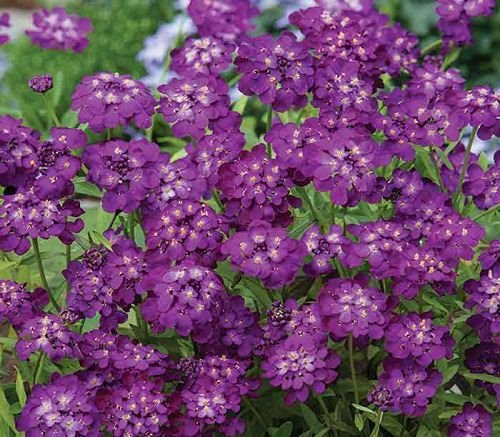 capegazette
capegazette
Botanical Name: Iberis
USDA Zones: 3-9
Container Gardening: Possible
Its Purple flowers grow so low that they appear like coming out from the ground, making them excellent groundcovers.
Growing Tip: Candytuft prefers full sun and well-drained soil. Water moderately, allowing the soil to dry slightly between watering sessions. Fertilize sparingly to encourage blooming.
Learn about Purple Diamond Loropetalum Care here
28. Coneflower

Botanical Name: Echinacea
USDA Zones: 3-9
Container Gardening: Possible
They are easy to grow, attract pollinators, tolerate heat and drought, and look stunning! Coneflowers are truly amazing.
Growing Tip: Coneflowers love full sun, well-draining soil, and moderate watering. Fertilize in spring to support vigorous growth and vibrant blooms.
29. Common Comfrey

Botanical Name: Symphytum officinale
USDA Zones: 3-10
Container Gardening: Possible
Comfrey is a medicinal herb with tubular Purple flowers that appear as if they are dropping down from the hairy foliage and stem.
Growing Tip: Common Comfrey thrives in partial to full sun and well-drained soil. Keep the soil consistently moist and apply organic compost or fertilizer occasionally.
30. Garden Cosmos
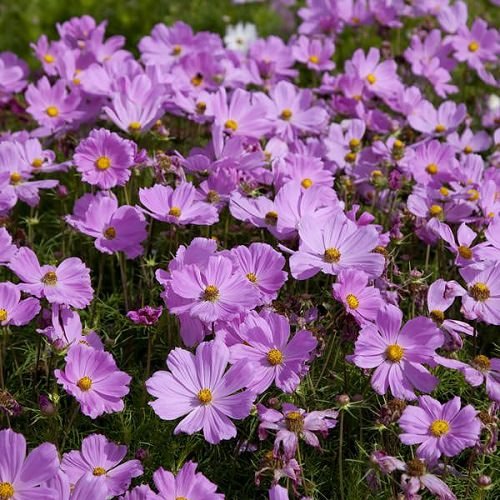
Botanical Name: Cosmos bipinnatus
USDA Zones: 2-11
Container Gardening: Possible
Blooming for months, this ornamental beauty can grow just by scattering the seeds. Its Purple flowers add a lot of appeal to the gardens.
Growing Tip: Garden Cosmos prefers full sun and well-draining soil. Water moderately and avoid over-fertilizing to encourage natural growth and profuse flowering.
31. Melastoma
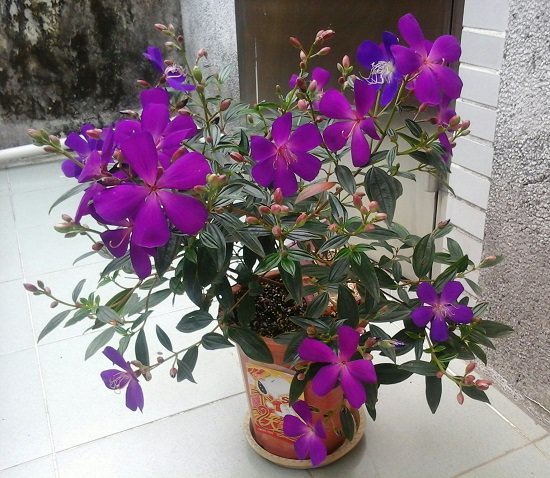
Botanical Name: Melastoma
USDA Zones: 10-11
Container Gardening: Possible
The Melastoma genus has beautiful Purple flowering bush and shrubs. Some of them have true Purple flowers. You can also grow melastoma in pots easily.
Growing Tip: Melastoma does well in full sun to partial shade and prefers well-draining soil. Keep the soil consistently moist but not waterlogged.
32. Cattleya Orchids
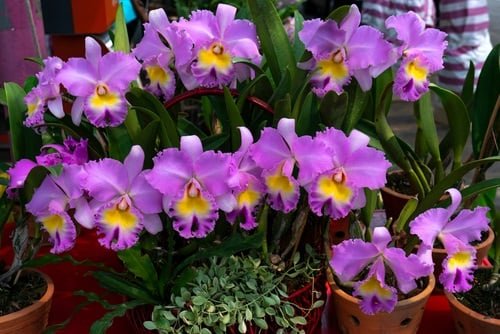
Botanical Name: Cattleya
USDA Zones: 10-11
Container Gardening: Possible
The Cattleya genus has beautiful hybrid scented orchid varieties available in many colors, but the original Cattleya comes in a bright purple color.
Growing Tip: Cattleya Orchids require bright, indirect light and a well-draining orchid mix. Water moderately, allowing the roots to dry slightly between waterings. Fertilize regularly with an orchid-specific fertilizer.
Find out the herbs with purple flowers here
33. Carnation
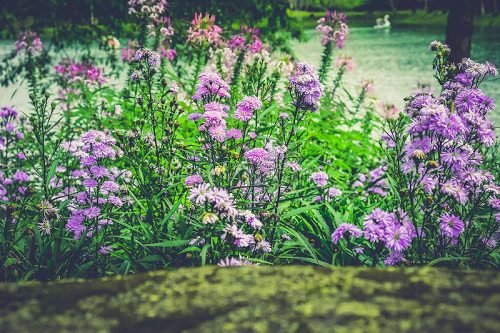
Botanical Name: Dianthus Caryophyllus
USDA Zones: 3-9
Container Gardening: Possible
“The Flowers of God” is another name they go by, a name which suits these Purple flowers perfectly.
Growing Tip: Carnations thrive in full sun and well-drained soil. Keep the soil consistently moist and apply a balanced fertilizer during the growing season.
34. Hollyhock
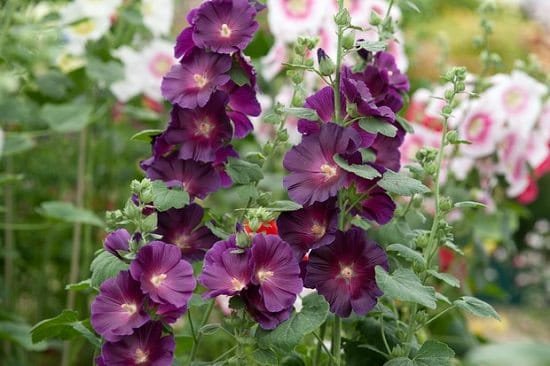
Botanical Name: Alcea
USDA Zones: 3-9
Container Gardening: Possible
Numerous flowers cover the tall spikes, which can grow as tall as 8-10 feet. If you want to grow the Best types of purple flowers, then do not miss this one!
Growing Tip: Hollyhocks prefer full sun and well-draining soil. Keep the soil consistently moist, especially during dry spells, and fertilize in early spring for robust growth and towering spikes of flowers.
35. China Aster
 davesgarden
davesgarden
Botanical Name: Callistephus chinensis
USDA Zones: 2-11
Container Gardening: Possible
Blooming profusely from early summer to fall, you can enjoy them on the patio or deck in small containers.
Growing Tip: China Asters do well in full sun with well-draining soil. Water moderately and apply a balanced fertilizer during the growing season for an abundance of colorful blooms.
36. Camas Lily

Botanical Name: Camassia
USDA Zones: 4-9
Container Gardening: Possible
Also known as wild hyacinth and Indian lily, it has beautiful purple, blue, or white flowers, depending on the cultivar.
Growing Tip: Camas Lilies thrive in full sun to partial shade and well-draining soil. Keep the soil consistently moist, especially during the growing season.
37. Blue-Eyed Grass
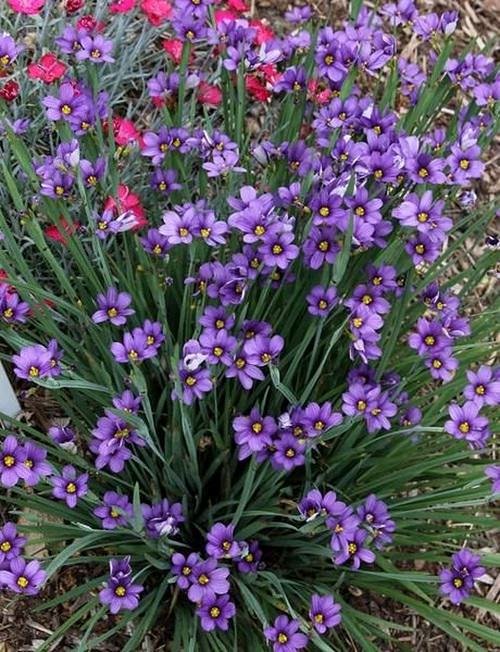
Botanical Name: Sisyrinchium
USDA Zones: 3-9
Container Gardening: Possible
Technically, it’s a member of the Iris family. The foliage resembles grass due to its thin blade-like appearance, and it grows lovely Purple flowers.
Growing Tip: Blue-Eyed Grass prefers full sun to partial shade and well-drained soil. Water moderately, allowing the soil to dry between watering sessions.
38. Bee Orchid

Botanical Name: Ophrys Apifera
USDA Zones: 2-11
Container Gardening: Possible
Uniquely shaped Bee orchid mimics the female bee in shape and thus attracts the male flies. It is one of the best purple flowers you can grow!
Growing Tip: Bee Orchids typically grow in full sun to partial shade, with well-draining soil. Water sparingly, allowing the soil to slightly dry between waterings.
Check out the best purple and white flowers here
39. Anemone
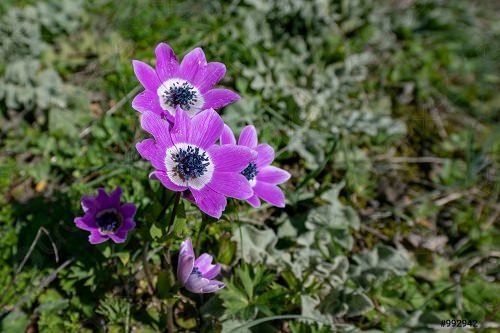
Botanical Name: Anemone coronaria
USDA Zones: 4-9
Container Gardening: Possible
Anemones come in colors like red, pink, white, magenta, purple, and blue. You can also grow them in pots.
Growing Tip: Anemones do well in full sun and well-draining soil. Keep the soil consistently moist, and apply a balanced fertilizer during their growing season for prolific flowering.
40. Lily of the Nile
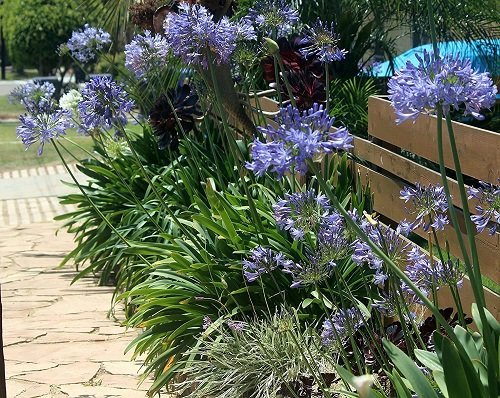
Botanical Name: Agapanthus
USDA Zones: 3-9
Container Gardening: Possible
Clusters of bright purple, blue, or white flowers form a rounded shape over a tall stalk that looks simply incredible.
Growing Tip: Lily of the Nile prefers full sun to partial shade and well-drained soil. Keep the soil consistently moist, especially during hot weather.
41. Hummelo
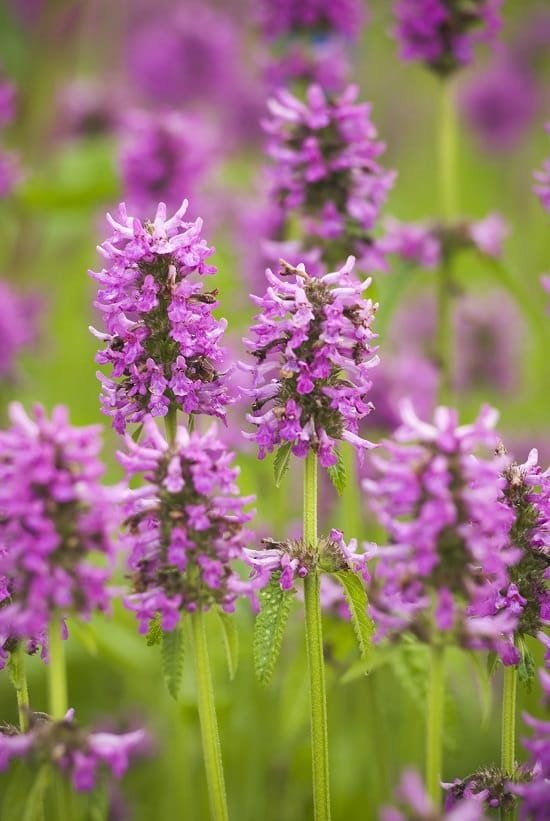
Botanical Name: Stachys monieri ‘Hummelo’
USDA Zones: 4-8
Container Gardening: Possible
Low-growing foliage is bestowed with tall spikes and clusters of flowers in mid-summer.
Growing Tip: Hummelo thrives in full sun to partial shade and well-drained soil. Maintain even moisture in the soil and fertilize lightly in spring to support its compact growth.
42. Wolf’s Bane
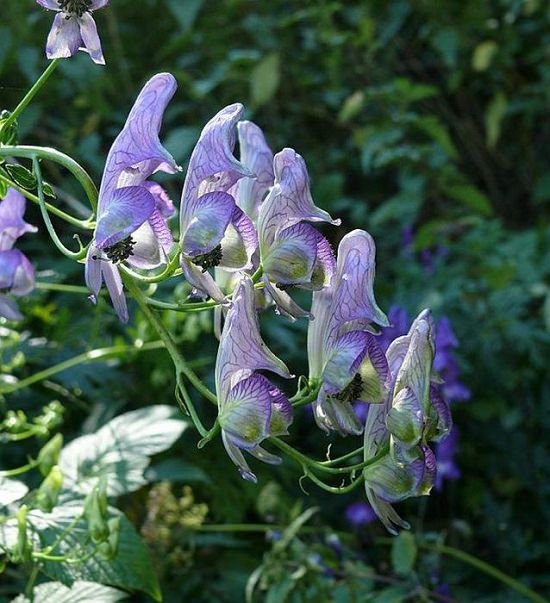
Botanical Name: Aconitum
USDA Zones: 3-7
Container Gardening: Possible
Also known as monkshood because the upper sepals of the florets resemble the monks’ hood, making it an interesting addition to any space.
Growing Tip: Wolf’s Bane does well in partial shade with well-drained soil. Keep the soil consistently moist, and avoid excessive fertilization.
43. Ornamental Allium

Botanical Name: Allium ‘Purple Sensation’
USDA Zones: 4-9
Container Gardening: Possible
Ornamental onions in the garden are as loved as the edible onions in the kitchen. Its Purple flowers look amazing as they form a globular shape.
Growing Tip: Ornamental Alliums prefer full sun and well-draining soil. Water moderately, and fertilize sparingly in spring for striking globe-shaped blooms.
44. Salvia
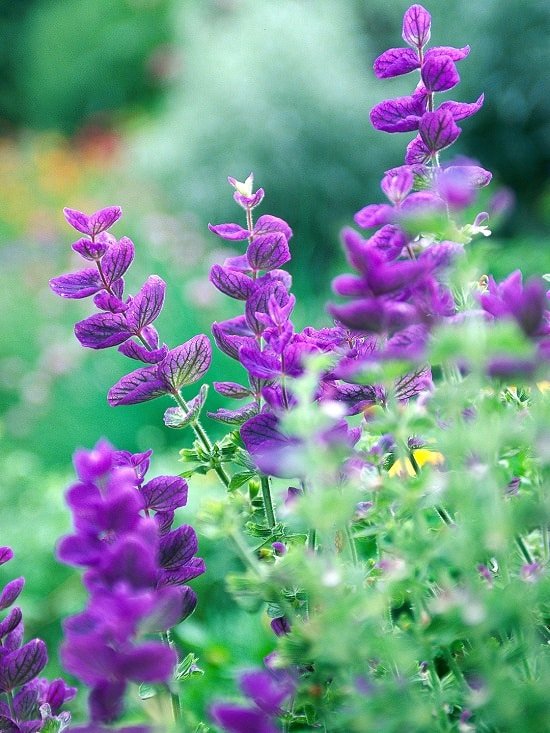
Botanical Name: Salvia
USDA Zones: 4-11
Container Gardening: Possible
Purple flowers names are incomplete without Salvia. You can find salvia flowers in colors of red, blue, and purple. They attract hummingbirds, bees, and butterflies.
Growing Tip: Salvias generally thrive in full sun with well-draining soil. They prefer moderate watering and benefit from occasional fertilization during the growing season.
45. Catmint

Botanical Name: Nepeta
USDA Zones: 3-9
Container Gardening: Possible
There are many ornamental varieties of this common herb that produce beautiful Purple flowers.
Growing Tip: Catmint prefers full sun and well-draining soil. Water moderately, and apply a balanced fertilizer during the growing season for continuous flowering.
Here are Weeds with Purple Flowers
46. Balloon Flower
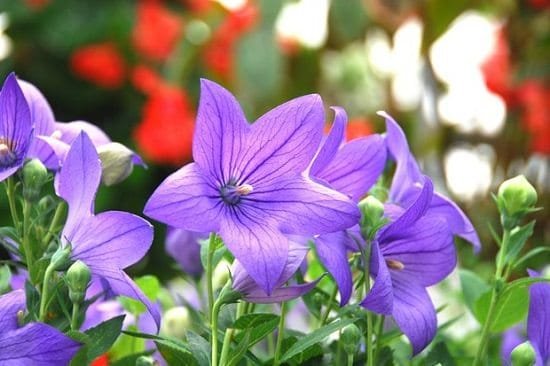
Botanical Name: Platycodon grandiflorus
USDA Zones: 3-8
Container Gardening: Possible
Before these Purple flowering plants blossom into a star-shaped glory, its puffy buds look like a balloon, hence the name.
Growing Tip: Balloon Flowers thrive in full sun and well-drained soil. Water moderately and fertilize lightly in spring for compact growth and unique balloon-like buds.
47. Iris Pumila

Botanical Name: Iris Pumila
USDA Zones: 3-9
Container Gardening: Possible
Its sword-shaped green foliage and deep Purple flowers are enough to fascinate anyone!
Growing Tip: Iris Pumila prefers full sun to partial shade and well-drained soil. Keep the soil consistently moist, especially during their growing season.
48. Leather Flower
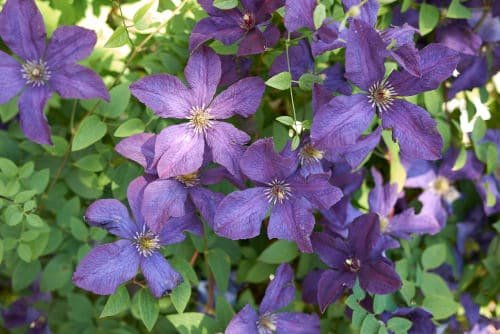 simonapavan/shutterstock
simonapavan/shutterstock
Botanical Name: Clematis
USDA Zones: 4-11
Container Gardening: Possible
Don’t get confused by the name. It’s the foliage that’s leathery, not the urn-shaped Purple flowers!
Growing Tip: Leather Flowers thrive in full sun to partial shade with well-drained soil. Keep the soil consistently moist, and fertilize lightly to support their climbing growth and abundant flowers.
Here are Stunning Blue and Purple Flowers
49. Lavender
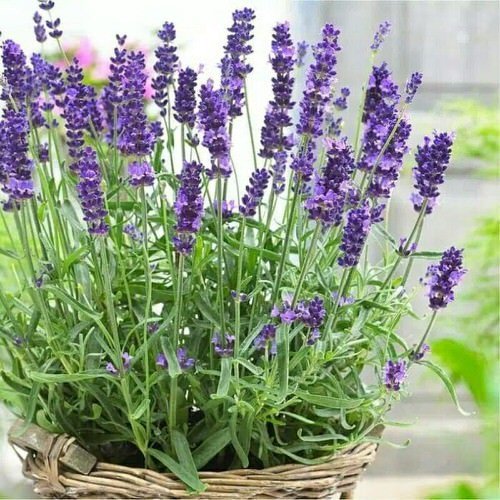
Botanical Name: Lavandula
USDA Zones: 5-9
Container Gardening: Possible
The sweet-smelling flowers will definitely elevate your mood if you are stressed out. Learn how to grow lavender here.
Growing Tip: Lavenders prefer full sun and well-drained, sandy soil. Water sparingly once established and avoid over-fertilization to maintain their aromatic foliage.
50. Lily of the Incas

Botanical Name: Alstroemeria
USDA Zones: 7-11
Container Gardening: Possible
The magnificent Purple flowers of this lily symbolize friendship and devotion. It also goes by the name Parrot Lily.
Growing Tip: Lily of the Incas prefers partial sun to full sun and well-draining soil. Keep the soil consistently moist, especially during the growing season.
51. Bell Heather
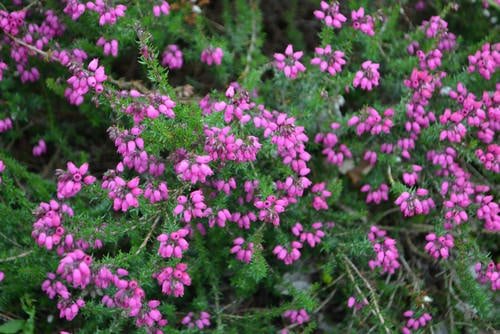 EditaMedeina/shutterstock
EditaMedeina/shutterstock
Botanical Name: Erica Cinerea
USDA Zones: 4-7
Container Gardening: Possible
It’s also known as Velvet night and blooms from late spring to early fall. Its Purple flowers come in tiny clusters and look adorable.
Growing Tip: Bell Heather thrives in full sun and well-drained, acidic soil. Water sparingly and avoid heavy fertilization.
52. Yesterday Today Tomorrow
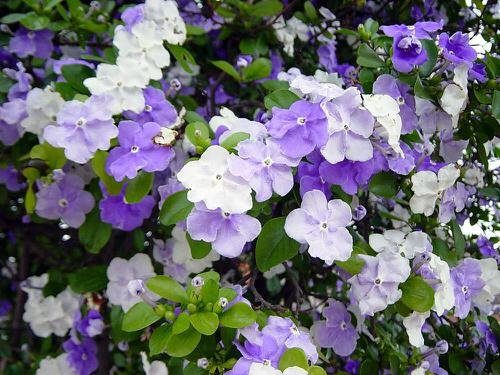
Botanical Name: Brunfelsia pauciflora
USDA Zones: 9-11
Container Gardening: Possible
Looking for Purple flowers names? Although it attracts with its beauty, the nightshade is a deadly plant with poisonous flowers and berries.
Growing Tip: Yesterday Today Tomorrow prefers full sun to partial shade and well-drained soil. Water moderately and fertilize lightly during the growing season.
Check out the best purple succulents here
53. Hyacinth

Botanical Name: Hyacinthus orientalis
USDA Zones: 4-9
Container Gardening: Possible
Long narrow leaves and dense clusters of charming Purple flowers of this spring bulb truly make it one of the best flowers you can grow.
Growing Tip: Hyacinths do well in full sun to partial shade and well-draining soil. Keep the soil consistently moist, especially when they’re actively growing.
54. Evening Primroses
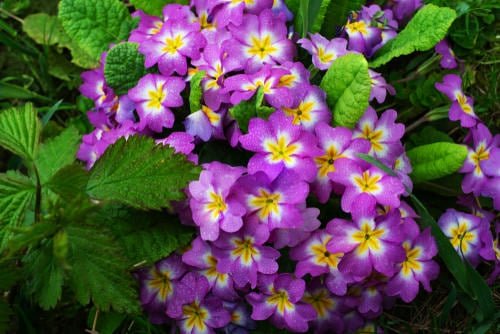 BoikoViktor/shutterstock
BoikoViktor/shutterstock
Botanical Name: Onagraceae
USDA Zones: 3-11
Container Gardening: Possible
The seeds are rich in omega-6, but it’s the attractive goblet-shaped Purple flowers add value to it.
Growing Tip: Evening Primroses prefer full sun and well-drained soil. Water moderately and apply a balanced fertilizer during their growing season for profuse blooms.
55. Bougainvillea
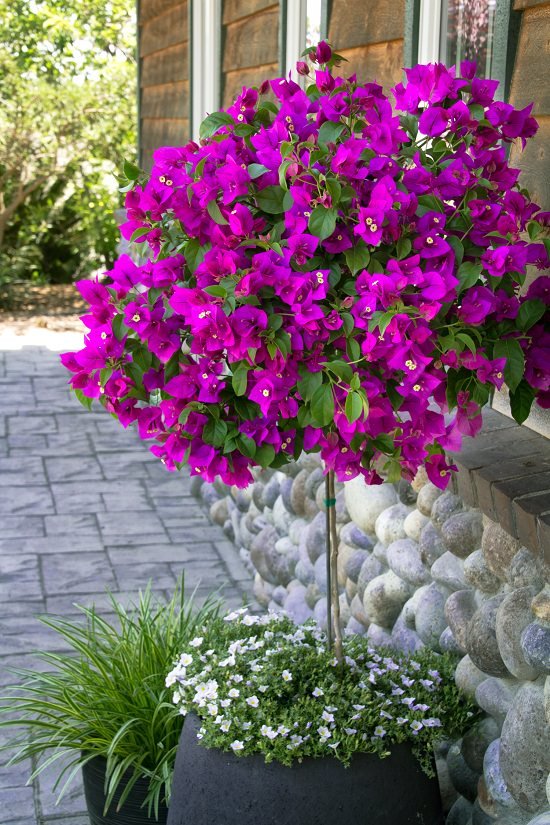 Image Credit: Monrovia
Image Credit: Monrovia
Botanical Name: Bougainvillea glabra
USDA Zones: 9-11
Container Gardening: Possible
The purple cultivar of bougainvillea is as stunning as others. It is easy to grow and adds a lot of appeal to patios and balconies when grown in pots.
Growing Tip: Bougainvillea thrives in full sun with well-draining soil. Water sparingly, allowing the soil to dry between watering sessions, and fertilize lightly during the growing season.
56. Bittersweet Nightshade
 itslife
itslife
Botanical Name: Solanum dulcamara
USDA Zones: 4-11
Container Gardening: Possible
A berry-producing bloom should be grown with care as the berries could be toxic, but the bittersweet nightshade is perfect for fencing because its vines climb up and cover the fence or wall with cute Purple flowers.
Growing Tip: Bittersweet Nightshade does well in partial shade to full sun with well-drained soil. Keep the soil consistently moist, and avoid excessive fertilization.
Here are the best purple vines you can grow as houseplants
57. Purple Reed Orchid
Botanical Name: Epidendrum radicans
USDA Zones: 10-11
Container Gardening: Possible
The Purple Reed Orchid enchants with its graceful, arching spikes adorned with delicate purple blossoms, creating an exquisite display of natural beauty.
Growing Tip: Purple Reed Orchids thrive in partial to full shade and well-draining, humus-rich soil. Keep the soil consistently moist, and provide regular fertilization during the growing season to support their elegant, purple-spiked flowers.
58. Lungwort
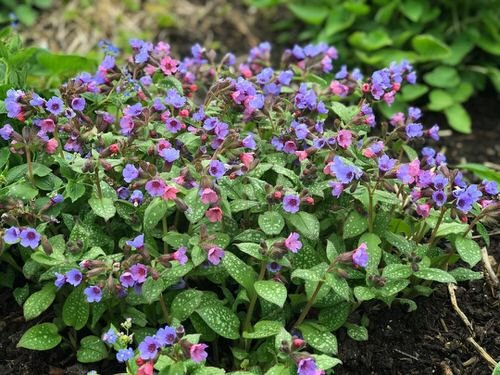 optimisticgardener
optimisticgardener
Botanical Name: Pulmonaria officinalis
USDA Zones: 3-9
Container Gardening: Possible
These Purple flowering plants are named after their mottled leaves that supposedly resemble the shape of lungs. The Funnel-shaped flowers are 𝐛𝐨𝐫𝐧e in shades of blue, pink, purple, violet, red, and white.
Growing Tip: Lungwort prefers partial to full shade and well-drained, humus-rich soil. Keep the soil consistently moist and apply organic compost or fertilizer occasionally.
59. Cheeses
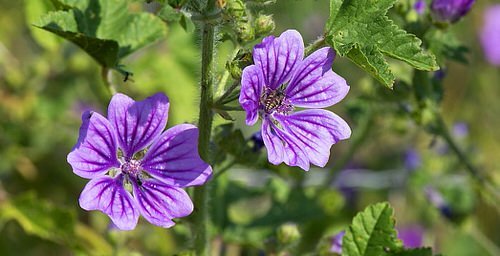
Botanical Name: Malva Sylvestris
USDA Zones: 3-8
Container Gardening: Possible
Also known as the common mallow, it’s very popular in Europe. The distinct purple petals of it lend a magical look to your garden.
Growing Tip: Cheeses do well in full sun to partial shade and well-drained soil. Keep the soil consistently moist, especially during dry spells.
60. Purple Pansy
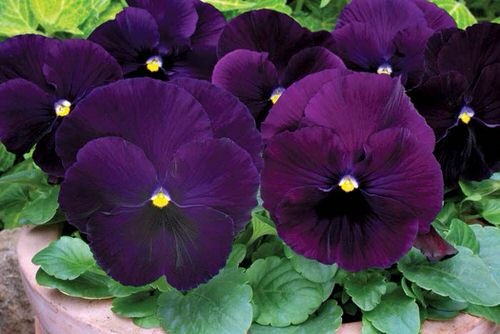
Botanical Name: Viola tricolor
USDA Zones: 3-9
Container Gardening: Possible
The colorful little flowers are an excellent choice for covering the ground right under taller plants, and they can also be grown as houseplants.
Growing Tip: Purple Pansies prefer partial sun to full sun and well-drained soil. Water moderately and apply a balanced fertilizer to encourage continuous flowering.
Have a look at the best purple foliage plants here
61. Sweet Rocket
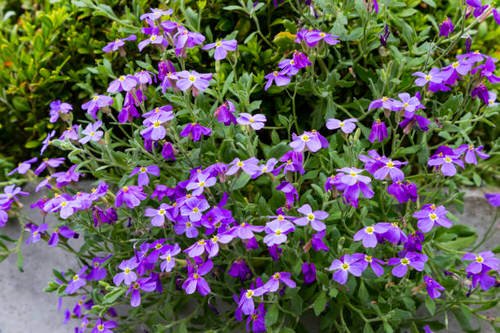
Botanical Name: Hesperis matronalis
USDA Zones: 3-9
Container Gardening: Possible
Sweet Rocket is a lovely, purple-or-white-flowered biennial with a pretty evening fragrance. It looks the best in a wildlife garden scheme or a cottage garden.
Growing Tip: Sweet rocket thrives in full sun to partial shade and well-drained soil. Keep the soil consistently moist and avoid over-fertilization.
62. Bugleweed
Botanical Name: Ajuga reptans
USDA Zones: 3-10
Container Gardening: Possible
Looking for a Weed with purple flowers? Bugleweed is a low-growing perennial with shiny, dark green leaves and spikes of blue or Purple flowers that add a beautiful pop of color to groundcovers or rock gardens.
Growing Tip: Bugleweed prefers partial shade to full sun and well-drained soil. Maintain even moisture in the soil and apply a balanced fertilizer lightly in spring.
63. Canterbury Bells
Botanical Name: Campanula medium
USDA Zones: 4-8
Container Gardening: Possible
Canterbury Bells are biennial Purple flowering plants with beautiful, large bell-shaped flowers in shades of blue, pink, or white, adding a delightful pop of color to gardens.
Growing Tip: Canterbury Bells do well in partial shade to full sun with well-drained soil. Keep the soil consistently moist and fertilize lightly during the growing season for bell-shaped blooms.
Here are the Best Purple Fruits to Grow in the Garden
64. Wild Indigo
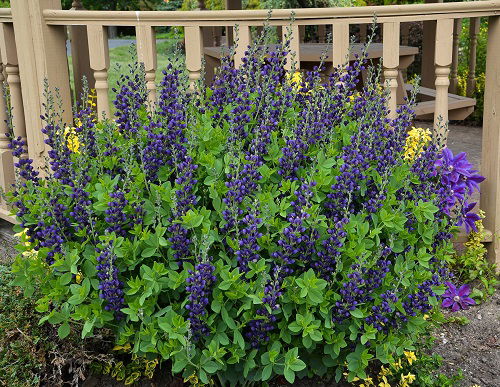 Walters Gardens
Walters Gardens
Botanical Name: Baptisia australis
USDA Zones: 3-9
Container Gardening: Possible
Wild Indigo is a striking perennial that produces tall spikes of pea-like flowers in shades of blue, purple, and yellow, providing a bold statement in any garden.
Growing Tip: Wild Indigo prefers full sun and well-draining soil. Water moderately, especially during the growing season, and avoid excessive fertilization.
65. Columbine
Botanical Name: Aquilegia
USDA Zones: 3-9
Container Gardening: Possible
Columbine is a stunning perennial with unique, bell-shaped flowers that come in a variety of colors, making it a must-have for any garden.
Growing Tip: Columbines prefer partial shade to full sun, well-draining soil, and moderate watering. They thrive when provided with consistent moisture. Occasional feeding with a balanced fertilizer promotes healthy growth and flowering.
66. Cornflower
Botanical Name: Centaurea cyanus
USDA Zones: 2-11
Container Gardening: Possible
With captivating blooms of purple and blue that can be easily grown, Cornflower is one of the Best purple flowers on our list.
Growing Tip: Cornflower is a charming annual with blue-gray foliage and bright blue flowers that add a delightful splash of color to gardens or mixed borders.
67. Delphinium
Botanical Name: Delphinium
USDA Zones: 3-7
Container Gardening: Possible
Delphinium is one of the best Types of purple flowers and is a tall and elegant perennial with showy spikes of blue, pink, purple, or white flowers that add a graceful touch to your home.
Growing Tip: Delphiniums prefer full sun with well-drained soil. Keep the soil consistently moist, especially during hot weather, and fertilize in early spring for tall, vibrant flower spikes.
68. Echium
Botanical Name: Echium vulgare
USDA Zones: 3-11
Container Gardening: Possible
Echium, also known as Viper’s Bugloss, features tall spikes of blue, purple, or pink flowers that bloom in early summer and attract bees and butterflies to the garden.
Growing Tip: Echiums thrive in full sun and well-drained soil. Water moderately and avoid over-fertilization to encourage their impressive flower spikes.
Here are Beautiful Landscaping with Purple Plants Ideas
69. Foxglove
Botanical Name: Digitalis purpurea
USDA Zones: 4-8
Container Gardening: Possible
Foxglove is a beautiful biennial with tall spikes of tubular flowers in shades of pink, purple, white, and yellow, making it a favorite of hummingbirds.
Growing Tip: Foxgloves do well in partial shade to full sun with well-drained soil. Keep the soil consistently moist, especially during their growing season.
70. Gomphrena
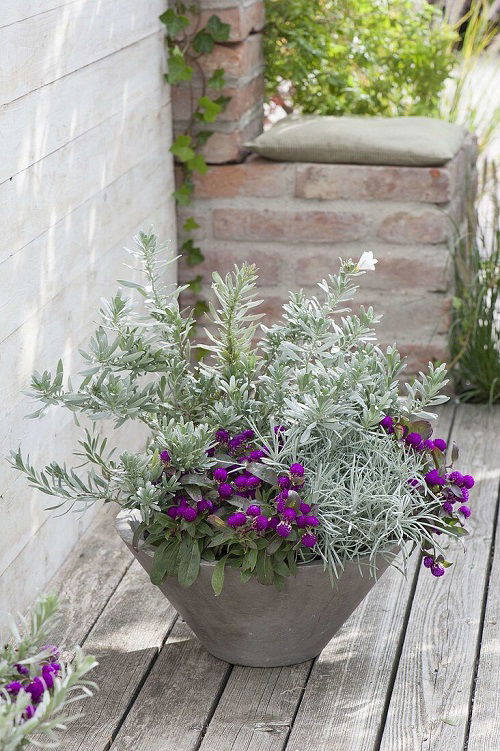
Botanical Name: Gomphrena globosa
USDA Zones: 2-11
Container Gardening: Possible
Gomphrena, also called Globe Amaranth, is an eye-catching annual that blooms all summer long, sporting round, brightly colored flowers that make great additions to borders and containers.
Growing Tip: Gomphrena prefers full sun and well-draining soil. Water moderately and apply a balanced fertilizer during the growing season for globe-like blooms.
71. Heliotrope
Botanical Name: Heliotropium arborescens
USDA Zones: 10-11
Container Gardening: Possible
Heliotrope, a sweetly fragrant annual with clusters of Small purple flowers, is a popular plant for gardens, containers, and cut flower arrangements.
Growing Tip: Heliotropes prefer full sun and well-drained soil. Water consistently to keep the soil evenly moist, and avoid excessive fertilization.
72. Wandflower
 flickr
flickr
Botanical Name: Gaura
USDA Zones: 5-10
Container Gardening: Possible
Wandflower is a delicate perennial with tall, slender stems and butterfly-like flowers in shades of pink, white, and red, adding grace and movement to the garden.
Growing Tip: Wandflowers do well in full sun and well-drained soil. Keep the soil consistently moist but not waterlogged, and fertilize lightly during the growing season.
Here are the Best Purple Hostas
73. Liatris
Botanical Name: Liatris
USDA Zones: 3-9
Container Gardening: Possible
Liatris, also known as Blazing Star, is a tall and vibrant perennial with striking spikes of purple or white flowers, attracting bees and butterflies to your home.
Growing Tip: Liatris prefers full sun and well-draining soil. Keep the soil consistently moist, especially during hot spells, and apply a balanced fertilizer during the growing season for tall, spiky blooms.
74. Lilac Chaste Tree
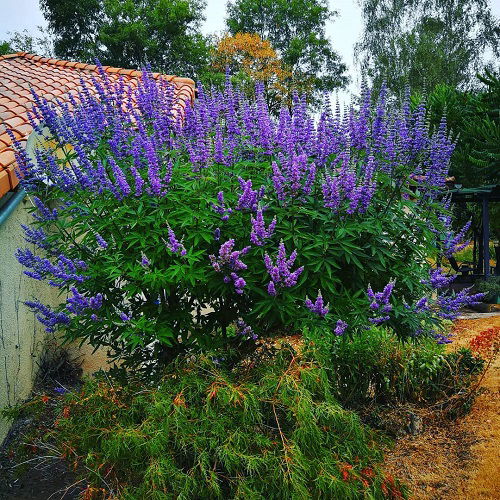 susan_p101
susan_p101
Botanical Name: Vitex agnus-castus
USDA Zones: 6-9
Container Gardening: Possible
Lilac Chaste Trees, a Tree with purple flowers, blooms with fragrant and lovely lilac-colored flowers in summer, making it a garden favorite and a butterfly magnet.
Growing Tip: Lilac Chaste Trees thrive in full sun and well-draining soil. Maintain even moisture in the soil and fertilize lightly in spring for aromatic blooms.
75. Lupin
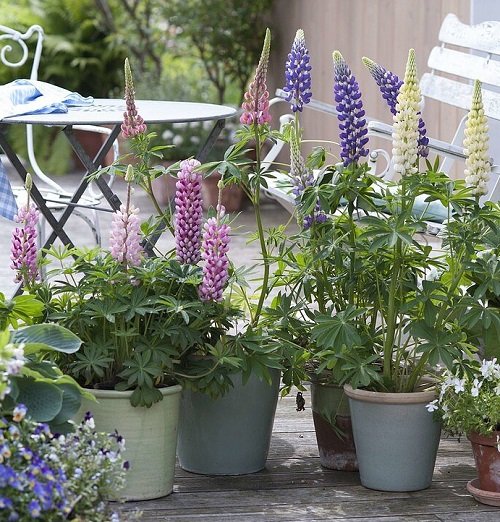
Botanical Name: Lupinus
USDA Zones: 4-8
Container Gardening: Possible
Lupins, tall and sturdy perennials, bear eye-catching spikes of flowers in shades of pink, purple, blue, and white, adding charm to any garden bed or border.
Growing Tip: Lupins prefer full sun and well-drained soil. Keep the soil consistently moist, and apply a balanced fertilizer during the growing season for impressive flower spikes.
Here are Stunning Succulents with Purple Flowers
76. Nemesia
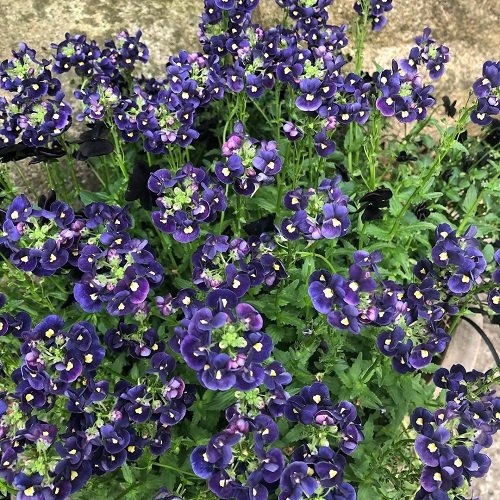 ojamozu
ojamozu
Botanical Name: Nemesia
USDA Zones: 8-10
Container Gardening: Possible
Nemesia, a lovely annual, boasts sweetly fragrant flowers in shades of pink, purple, white, and yellow, making it a popular choice for containers, hanging baskets, and borders.
Growing Tip: Nemesias do well in full sun to partial shade and well-drained soil. Keep the soil consistently moist, and fertilize lightly during the growing season for continuous flowering.
77. Osteospermum
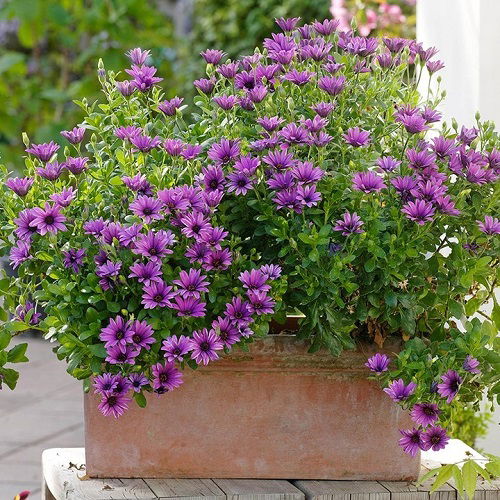 mrfothergills
mrfothergills
Botanical Name: Osteospermum
USDA Zones: 9-11
Container Gardening: Possible
Osteospermum, or Cape Daisy, is a stunning annual with large, daisy-like flowers in shades of purple, pink, orange, and white, adding vibrant pops of color to any garden.
Growing Tip: Osteospermums prefer full sun and well-drained soil. Water moderately and apply a balanced fertilizer during the growing season for colorful daisy-like blooms.
78. Creeping Phlox
Botanical Name: Phlox subulata
USDA Zones: 3-9
Container Gardening: Possible
Phlox subulata, also known as Creeping Phlox, is a charming evergreen groundcover with Small purple flowers in shades of pink, white, and blue, spreading delight wherever it grows.
Growing Tip: Creeping Phlox thrives in full sun and well-drained soil. Keep the soil consistently moist, especially during the growing season, and avoid overfertilization.
Discover the Best Purple and Yellow Flowers here
79. Rock Cress
 gardenworks
gardenworks
Botanical Name: Arabis
USDA Zones: 4-7
Container Gardening: Possible
Another of the most amazing Types of purple flowers, Rock Cress, or Arabis, is a low-growing perennial with small, fragrant flowers in hues of pink, purple, and white, providing excellent ground cover for rock gardens and borders.
Growing Tip: Rock Cress prefers full sun and well-draining soil. Water moderately and apply a balanced fertilizer lightly during the growing season for a carpet of colorful blossoms.
80. Meadow Sage
Botanical Name: Salvia nemorosa
USDA Zones: 4-8
Container Gardening: Possible
Salvia nemorosa, or Meadow Sage, is a stunning perennial with spikes of Small purple flowers, providing beautiful height and color to garden beds.
Growing Tip: Meadow Sage thrives in full sun and well-drained soil. Water moderately, and apply a balanced fertilizer during the growing season for spiky, colorful blooms.
81. Speedwell
Botanical Name: Veronica
USDA Zones: 3-9
Container Gardening: Possible
Speedwell, a charming perennial with spikes of blue, pink, or white flowers, is a great choice for borders or as a groundcover, providing beauty and pollinator attraction to any garden.
Growing Tip: Speedwells do well in full sun to partial shade with well-drained soil. Keep the soil consistently moist and fertilize lightly during the growing season for vibrant spires of flowers.
82. Spiderwort
Botanical Name: Tradescantia
USDA Zones: 4-9
Container Gardening: Possible
Spiderwort, or Tradescantia, is a resilient perennial with clusters of blue, purple, or pink flowers, adding a delightful touch of color to your home or garden.
Growing Tip: Spiderworts prefer full sun to partial shade and well-drained soil. Keep the soil consistently moist, and apply a balanced fertilizer during the growing season for their distinctive, three-petaled flowers.
Here are Stunning White Flowers with Purple Center
83. Purple Moss Rose
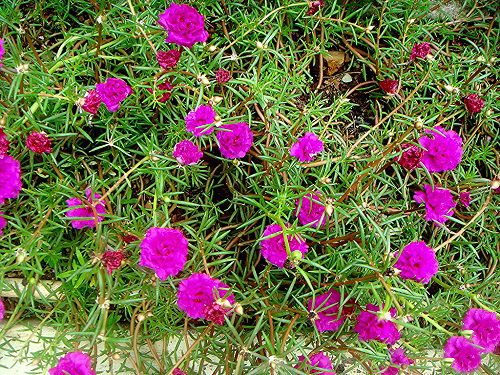
flickr
Botanical Name: Portulaca grandiflora ‘Purple’
USDA Zones: 2-11
Container Gardening: Possible
With its vibrant, almost neon Purple flowers and succulent leaves, this low-growing plant is a popular choice for rock gardens and hot, dry areas.
Growing Tip: Purple Moss Roses love full sun and well-drained soil. Water sparingly, allowing the soil to dry between watering sessions, and avoid excessive fertilization for continuous flowering.
84. Peony
Botanical Name: Paeonia
USDA Zones: 3-8
Container Gardening: Possible
These showy, fragrant flowers come in a range of colors, including deep purple, and are a beloved symbol of spring and renewal.
Growing Tip: Peonies prefer full sun to partial shade and well-drained soil. Keep the soil consistently moist, especially during their growing season in spring, and fertilize lightly for large, fragrant blooms.
Here are Beautiful Types of Purple Peony Varieties
85. Snapdragon
Botanical Name: Antirrhinum majus
USDA Zones: 7-10
Container Gardening: Possible
With its distinctive “dragon’s mouth” shape, the snapdragon boasts tall spikes of colorful blooms that are a favorite of hummingbirds and butterflies.
Growing Tip: Snapdragons thrive in full sun with well-draining soil. Water moderately and apply a balanced fertilizer during the growing season for a colorful display of snap-like blossoms.
86. Thistle
Botanical Name: Cirsium vulgare
USDA Zones: 2-9
Container Gardening: Possible
The prickly thistle’s vibrant Purple flowers are a striking sight in fields and meadows and are often used as a symbol of Scotland.
Growing Tip: Thistles prefer full sun and well-drained soil. Water sparingly, allowing the soil to slightly dry between waterings, and avoid excessive fertilization.
Have a look at the Best Weeds with White Flowers here
87. Dahlia
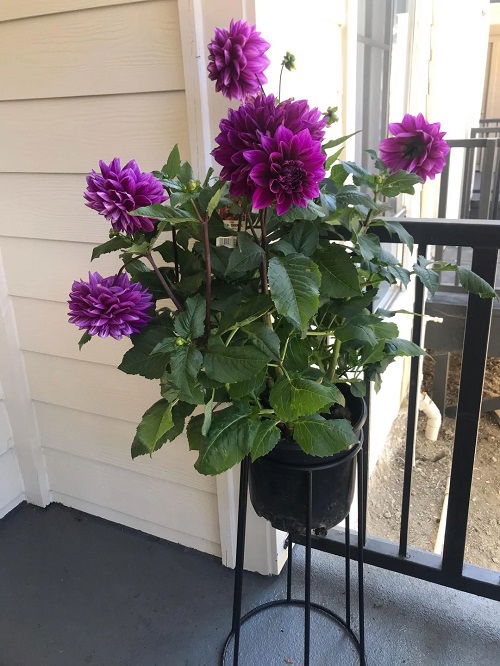
Botanical Name: Dahlia
USDA Zones: 8-11
Container Gardening: Possible
These showy flowers come in a range of sizes and shades, from deep purple to nearly black, and are prized for their bold, sculptural form.
Growing Tip: Dahlias love full sun and well-drained soil. Keep the soil consistently moist, and apply a balanced fertilizer during the growing season for a wide variety of showy blooms.
88. Jacaranda
Botanical Name: Jacaranda mimosifolia
USDA Zones: 9-11
Container Gardening: Possible
This Tree with purple flowers has delicate, trumpet-shaped lavender flowers that create a stunning canopy of color in the spring, filling the air with a sweet fragrance.
Growing Tip: Jacarandas thrive in full sun and well-drained soil. Water moderately, especially during dry spells, and avoid heavy fertilization for their distinctive lavender-blue blossoms.
89. Persian Buttercup
Botanical Name: Ranunculus asiaticus
USDA Zones: 8-11
Container Gardening: Possible
With its tightly packed petals and brilliant hue, the Persian buttercup is a popular choice for wedding bouquets and garden borders alike.
Growing Tip: Persian Buttercups prefer full sun to partial shade and well-draining soil. Keep the soil consistently moist, especially during their growing season, and fertilize lightly for lush, colorful blooms.
Here are Beautiful Flowers that Come Back Every Year
90. Muscari
Botanical Name: Muscari
USDA Zones: 3-9
Container Gardening: Possible
These small, delicate flowers, also known as grape hyacinths, have a unique, fragrant scent and come in a range of shades from pale lavender to deep purple.
Growing Tip: Muscari bulbs thrive in full sun to partial shade with well-drained soil. Keep the soil consistently moist, especially during their active growing period in spring.
91. Bergamot
Botanical Name: Monarda didyma
USDA Zones: 4-9
Container Gardening: Possible
The fragrant Purple flowers of this herb are prized for their use in teas and perfumes and are a favorite of pollinators.
Growing Tip: Bergamots prefer full sun to partial shade and well-drained soil. Keep the soil consistently moist, and apply a balanced fertilizer during the growing season for vibrant, aromatic flowers.
92. Leucanthemum
Botanical Name: Leucanthemum
USDA Zones: 4-8
Container Gardening: Possible
Although commonly associated with white daisies, some varieties of Leucanthemum have striking purple centers that add a pop of color to any garden.
Growing Tip: Leucanthemums do well in full sun and well-draining soil. Water moderately, and apply a balanced fertilizer during the growing season for classic daisy-like blooms.
93. Doubtful Knight’s Spur
Botanical Name: Consolida ajacis
USDA Zones: 2-9
Container Gardening: Possible
With their tall spikes of spiky purple blooms, Doubtful Knight’s-spur is a striking addition to any garden, often used in floral arrangements and bouquets.
Growing Tip: Doubtful Knight’s Spurs thrive in full sun and well-drained soil. Keep the soil consistently moist, and avoid over-fertilization for tall, delicate-looking flowers.
Find How to Attract Bees to Your Garden here
94. Penstemon
Botanical Name: Penstemon
USDA Zones: 3-9
Container Gardening: Possible
These tall, spiky flowers have a distinctive tubular shape that makes them a favorite of hummingbirds and come in a range of shades from pale lavender to deep purple.
Growing Tip: Penstemons prefer full sun and well-drained soil. Water moderately, and apply a balanced fertilizer during the growing season for spiky, tubular blossoms.
95. Rudbeckia
Botanical Name: Rudbeckia hirta
USDA Zones: 3-9
Container Gardening: Possible
With its sunny yellow petals and dark purple center, this wildflower is a striking addition to any garden or bouquet.
Growing Tip: Rudbeckias do well in full sun to partial shade and well-drained soil. Keep the soil consistently moist and apply a balanced fertilizer during the growing season for cheerful, daisy-like flowers.
96. Statice
Botanical Name: Limonium
USDA Zones: 2-11
Container Gardening: Possible
These small, papery flowers come in shades of purple, blue, and pink and are prized for their use in dried floral arrangements.
Growing Tip: Statice prefers full sun and well-drained soil. Water moderately and apply a balanced fertilizer during the growing season for papery, long-lasting blooms.
97. Ageratum
Botanical Name: Ageratum houstonianum
USDA Zones: 2-11
Container Gardening: Possible
This low-growing plant is covered in clusters of fluffy, powder-blue flowers that are a favorite of butterflies and makes a lovely addition to borders and container gardens.
Growing Tip: Ageratums thrive in full sun to partial shade with well-drained soil. Keep the soil consistently moist and fertilize lightly for fluffy clusters of blue or white flowers.
Here are Beautiful Flowers that Attract Butterflies
98. Borage
Botanical Name: Borago officinalis
USDA Zones: 2-11
Container Gardening: Possible
With its vivid blue-purple blooms and fuzzy leaves, borage is a hardy and versatile herb that is often used in cooking, medicine, and cosmetics.
Growing Tip: Borages prefer full sun and well-drained soil. Water moderately, and avoid over-fertilization for their charming, star-shaped blossoms.
99. Calibrachoa
Botanical Name: Calibrachoa
USDA Zones: 9-11
Container Gardening: Possible
These small, petunia-like flowers come in a range of shades, including deep purple, and are a popular choice for hanging baskets and container gardens.
Growing Tip: Calibrachoas do well in full sun and well-drained soil. Keep the soil consistently moist, and apply a balanced fertilizer during the growing season for an abundance of small, trumpet-shaped flowers.
100. Clarkia
Botanical Name: Clarkia
USDA Zones: 2-11
Container Gardening: Possible
These delicate, cup-shaped flowers come in shades of pink, purple, and white and are a favorite of hummingbirds and butterflies.
Growing Tip: Clarkias prefer full sun and well-drained soil. Water moderately, and avoid excessive fertilization for their delicate, cup-shaped flowers.
101. Convolvulus
Botanical Name: Convolvulus
USDA Zones: 2-10
Container Gardening: Possible
This low-growing plant boasts bright purple, trumpet-shaped flowers that bloom all summer long and are a popular choice for rock gardens and borders.
Growing Tip: Convolvuluses thrive in full sun and well-drained soil. Water sparingly, allowing the soil to dry between waterings, and avoid heavy fertilization for their funnel-shaped blooms.
102. Yarrow
Botanical Name: Achillea millefolium
USDA Zones: 3-9
Container Gardening: Possible
These hardy, fern-like plants have clusters of small, flat-topped flowers in shades of pink, white, and purple.
Growing Tip: Yarrows prefer full sun and well-drained soil. Water moderately, especially during their growing season, and avoid excessive fertilization for their flat-topped clusters of small flowers.
Learn about Yarrow and other Best Sunflower Companion Plants here
103. Perovskia

Botanical Name: Perovskia atriplicifolia
USDA Zones: 4-9
Container Gardening: Possible
This tall, airy plant has aromatic silver-grey foliage and spikes of small, lavender-Purple flowers that are a favorite of bees and butterflies.
Growing Tip: Perovskias do well in full sun and well-drained soil. Water moderately and avoid over-fertilization for their aromatic, spiky blooms.
104. Torenia
Botanical Name: Torenia fournieri
USDA Zones: 10-11
Container Gardening: Possible
Torenia is a shade-loving plant that produces small, snapdragon-like flowers in shades of purple, blue, and pink.
Growing Tip: Torenias thrive in partial shade to full shade with well-drained soil. Keep the soil consistently moist and apply a balanced fertilizer during the growing season for their charming, tubular flowers.
105. Wallflower
Botanical Name: Erysimum
USDA Zones: 4-9
Container Gardening: Possible
With its spicy-sweet scent and clusters of bright purple, pink, and orange flowers, this hardy plant is a favorite of gardeners and pollinators alike.
Growing Tip: Wallflowers prefer full sun and well-drained soil. Water moderately, and apply a balanced fertilizer during the growing season for clusters of fragrant, four-petaled blooms.
Check out Splendid Perennial Flowers that Bloom for Decades here
106. Weigela
Botanical Name: Weigela florida
USDA Zones: 4-8
Container Gardening: Possible
This deciduous shrub produces masses of pink-purple trumpet-shaped flowers in late spring and is undoubtedly one of the most amazing Types of purple flowers.
Growing Tip: Weigelas do well in full sun to partial shade and well-drained soil. Keep the soil consistently moist, especially during dry spells, and apply a balanced fertilizer for their trumpet-shaped flowers.
107. Welsh Poppy
Botanical Name: Meconopsis cambrica
USDA Zones: 3-7
Container Gardening: Possible
With its bright yellow-orange flowers and delicate foliage, this plant is a favorite of gardeners looking to add a pop of color to shady areas.
Growing Tip: Welsh Poppies thrive in partial shade to full sun with well-drained soil. Keep the soil consistently moist and fertilize lightly for their cheerful, yellow, or orange flowers.
108. Zigadenus
Botanical Name: Zigadenus
USDA Zones: 4-8
Container Gardening: Possible
This tall, elegant plant produces spikes of small, star-shaped flowers in shades of white, pink, and purple and is a popular choice for wildflower gardens.
Growing Tip: Zigadenus plants do well in full sun and well-drained soil. Water sparingly, allowing the soil to dry between waterings, and avoid over-fertilization for their unique, star-shaped flowers.
109. Rain Lily
Botanical Name: Zephyranthes
USDA Zones: 7-11
Container Gardening: Possible
These small, star-shaped flowers are last on our Purple flowers names list and appear after rain showers in shades of pink, purple, and white and are a delightful surprise in any garden.
Growing Tip: Rain Lilies prefer full sun to partial shade and well-drained soil. Water moderately, especially during their growing season, for their charming, lily-like blooms.
